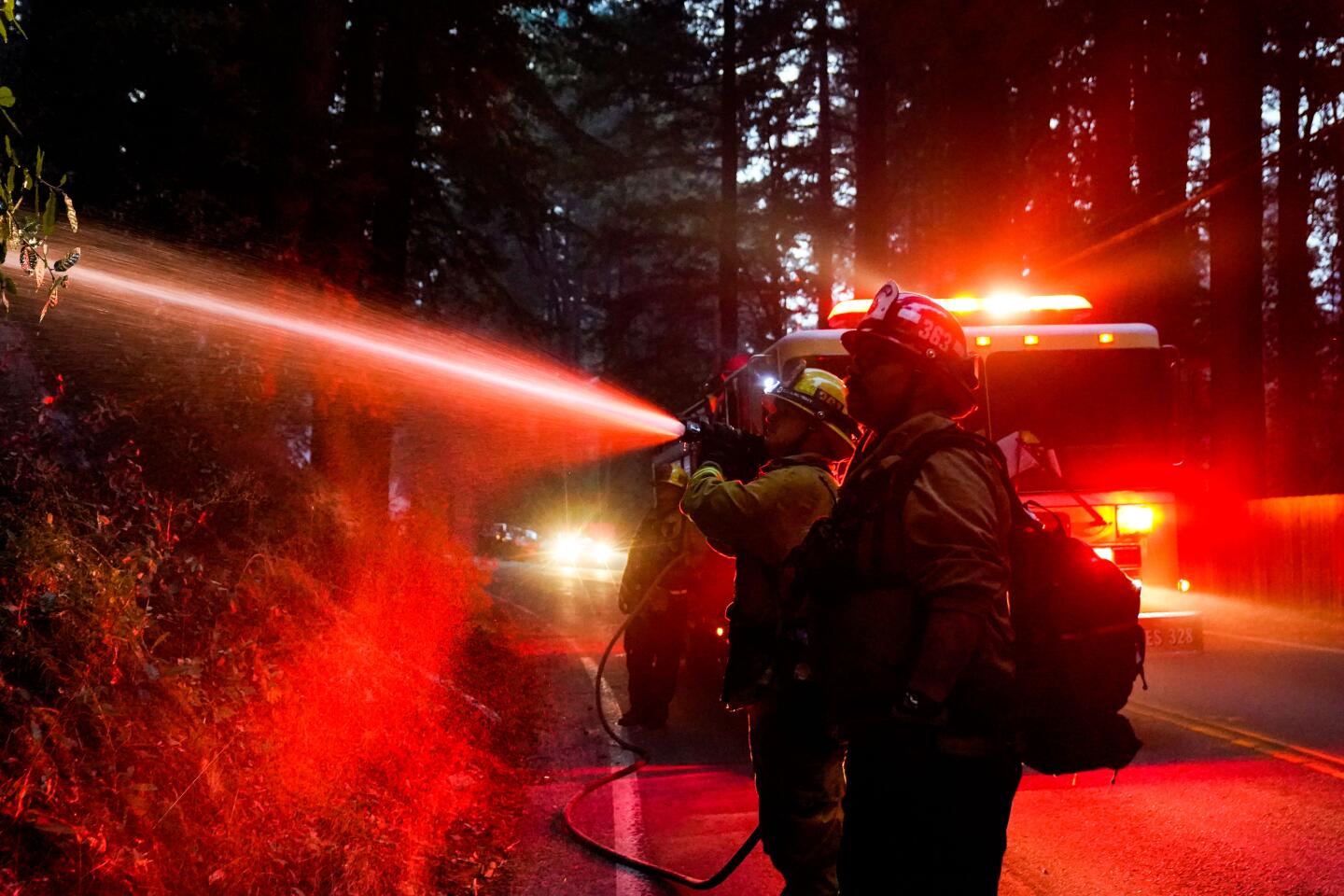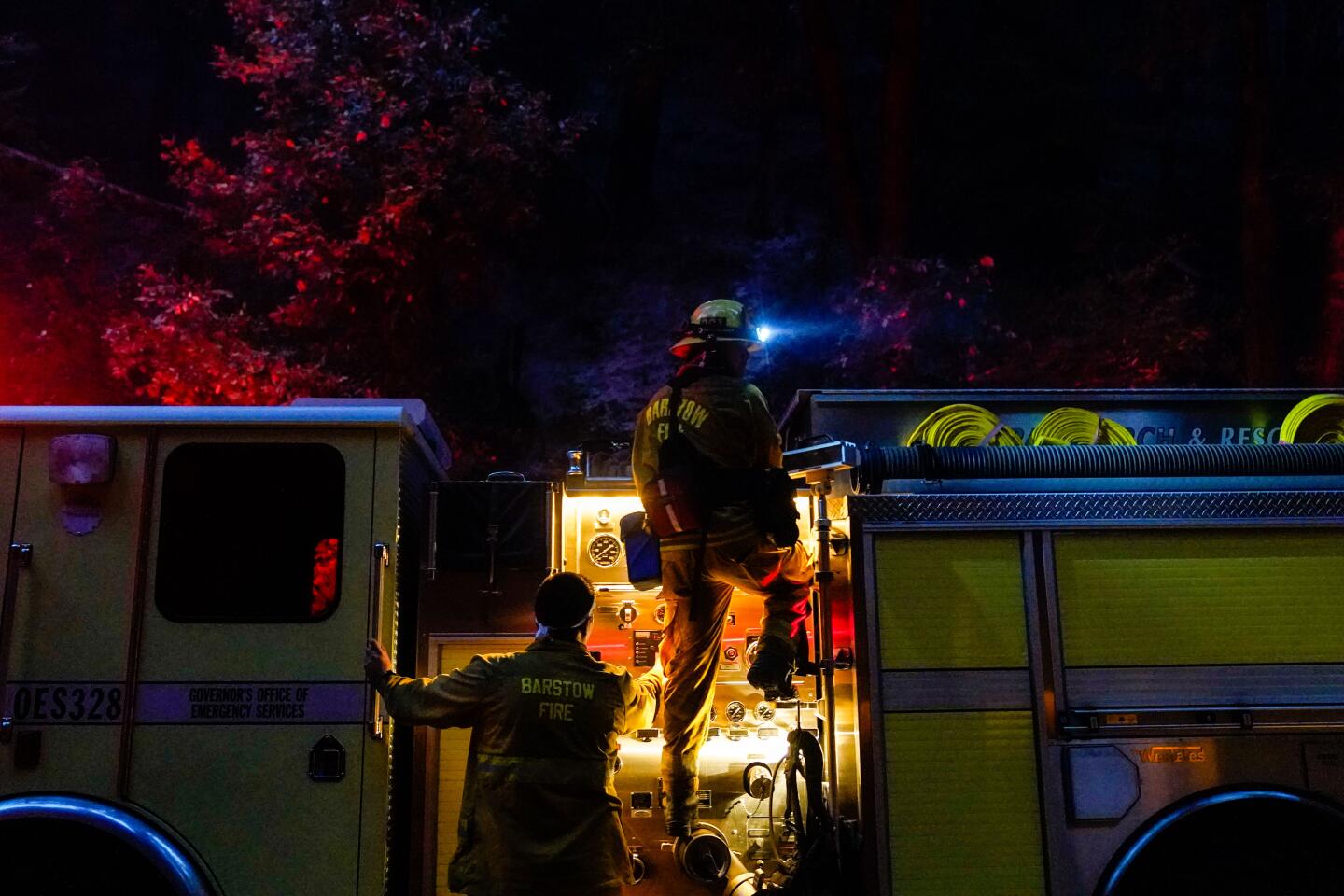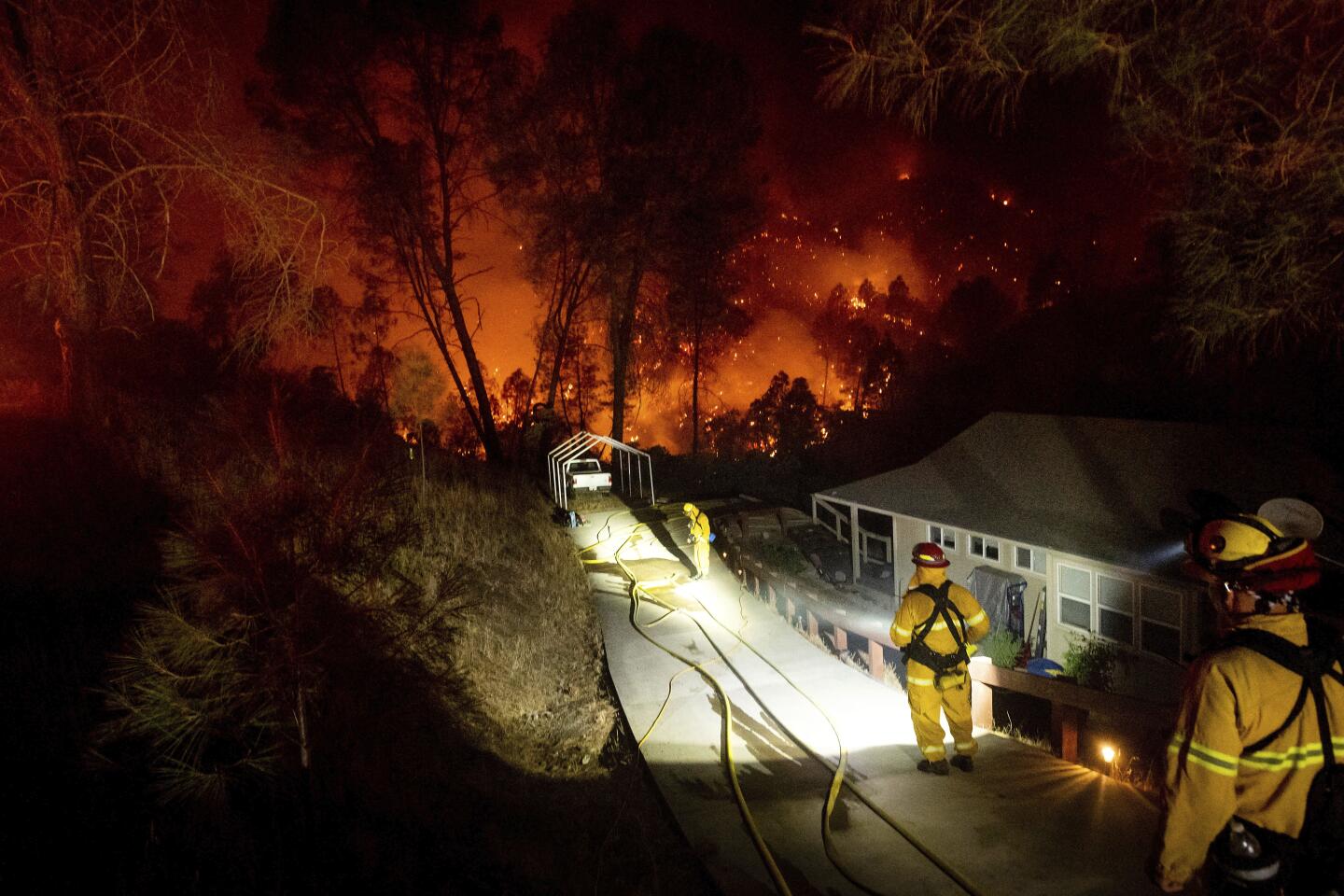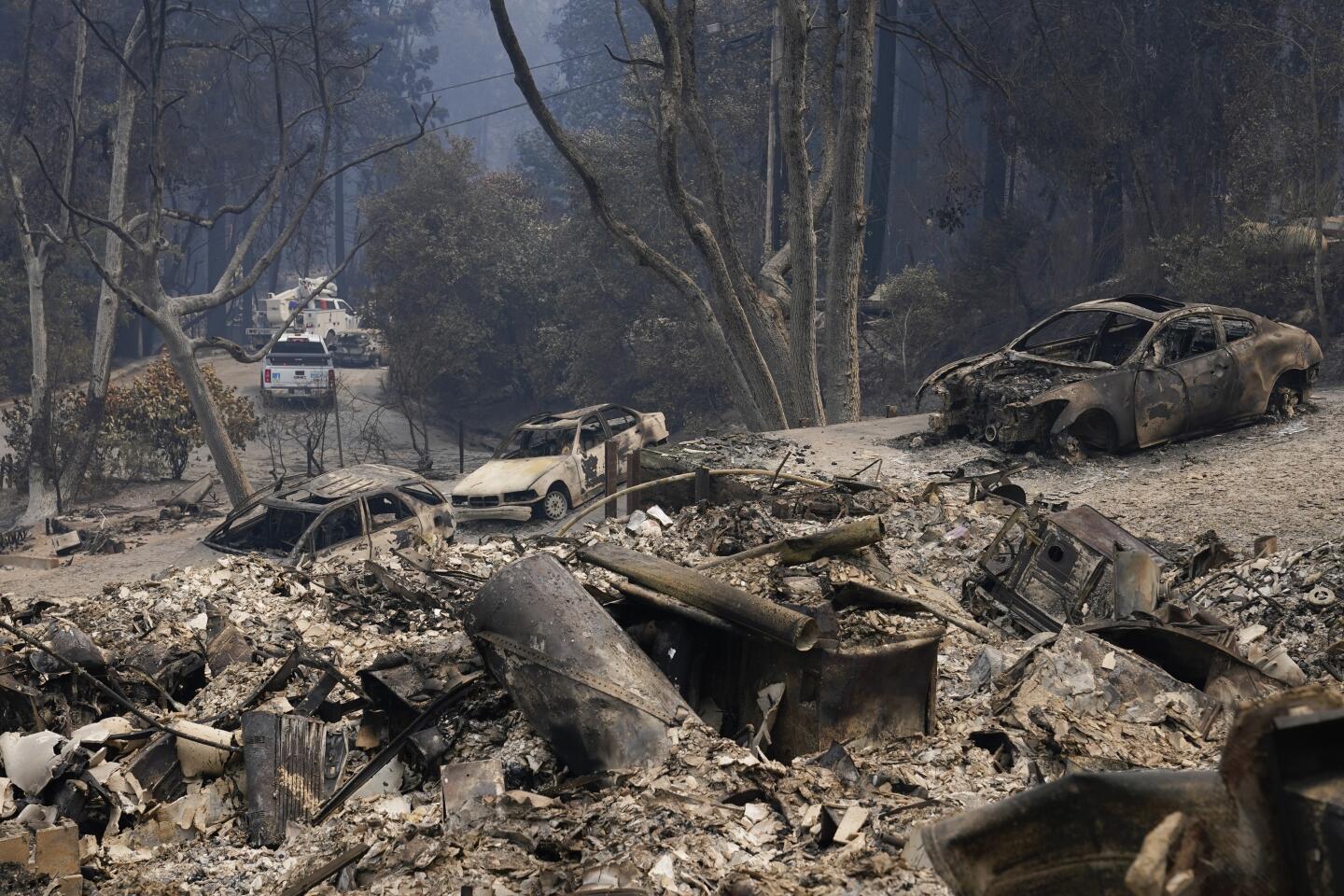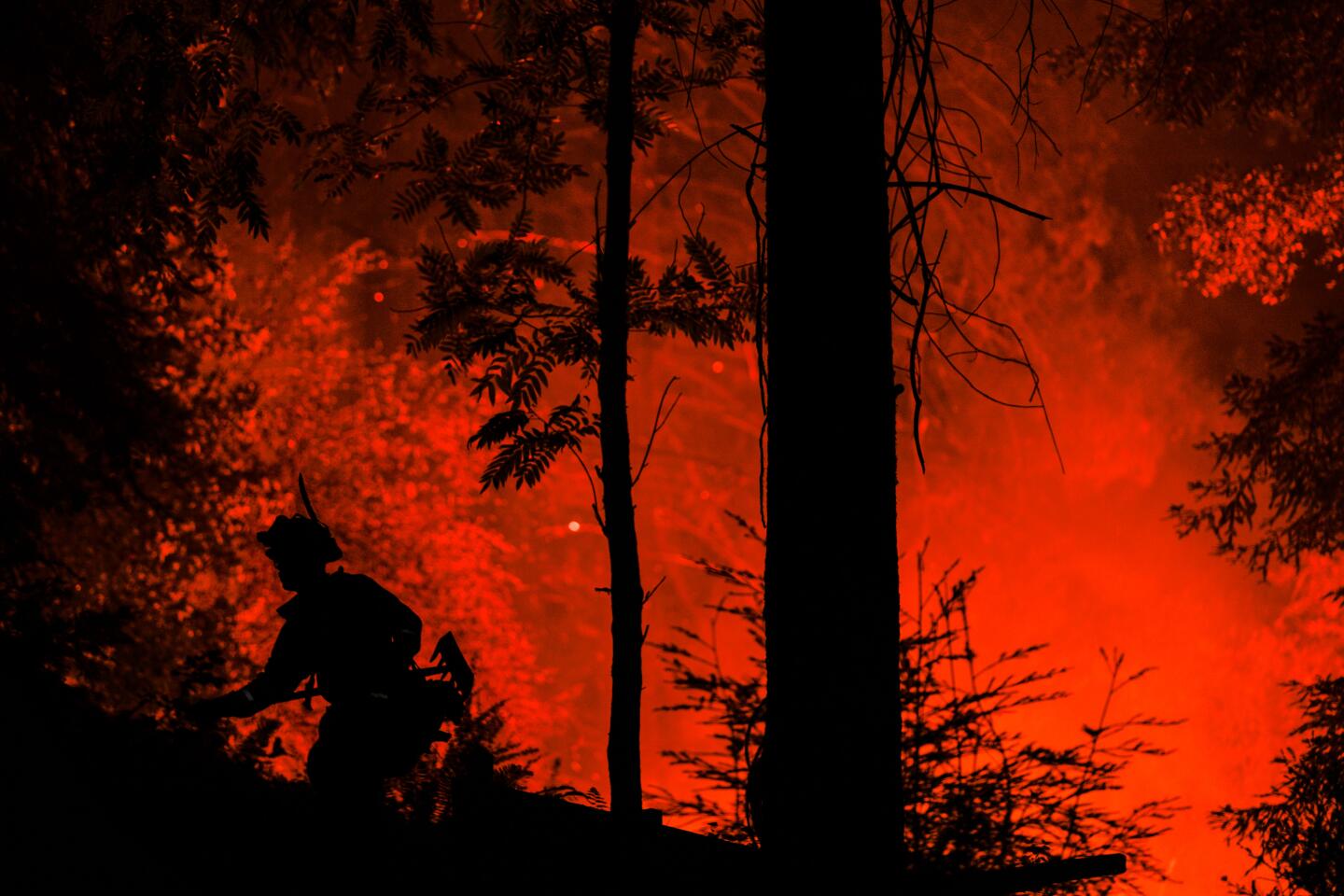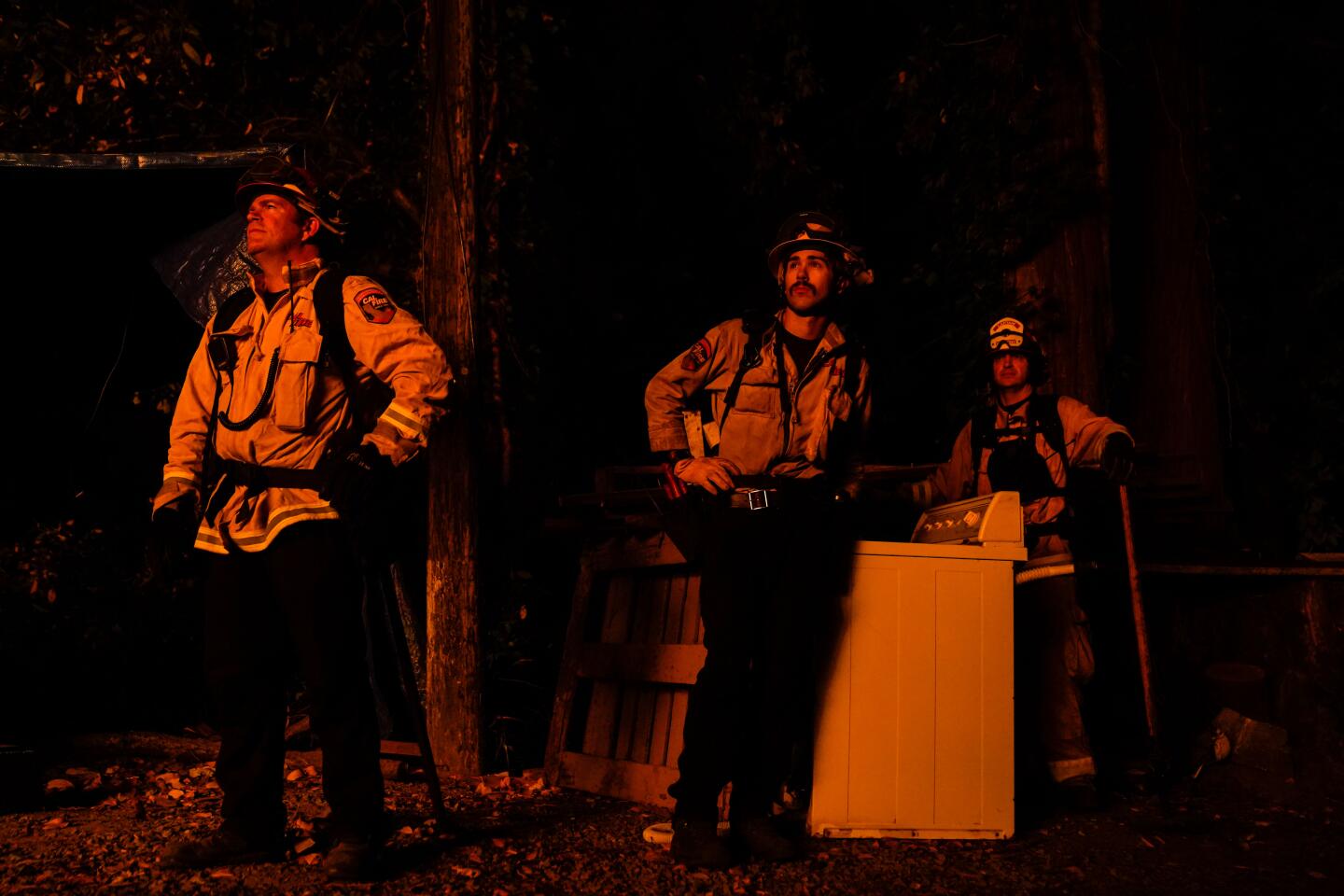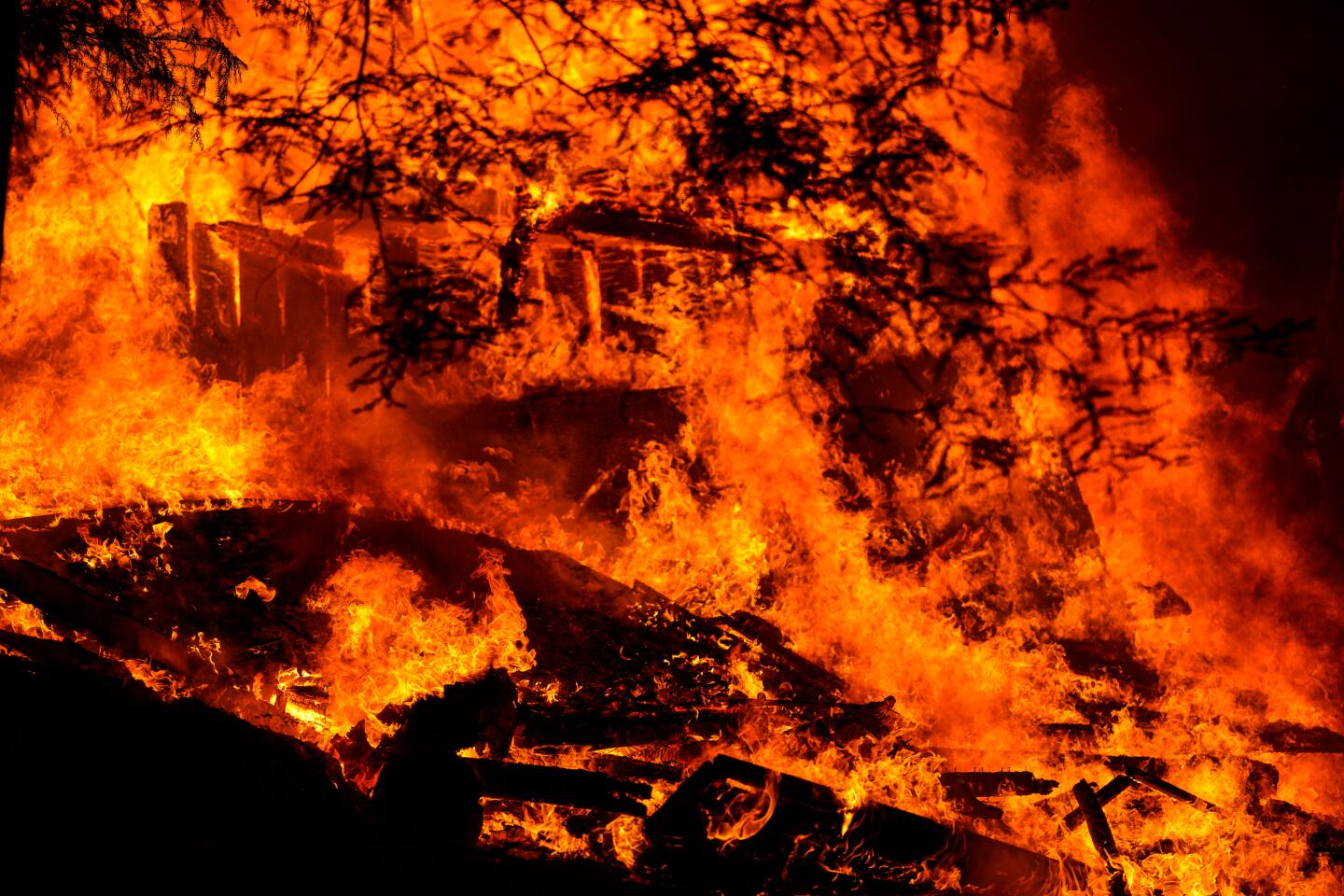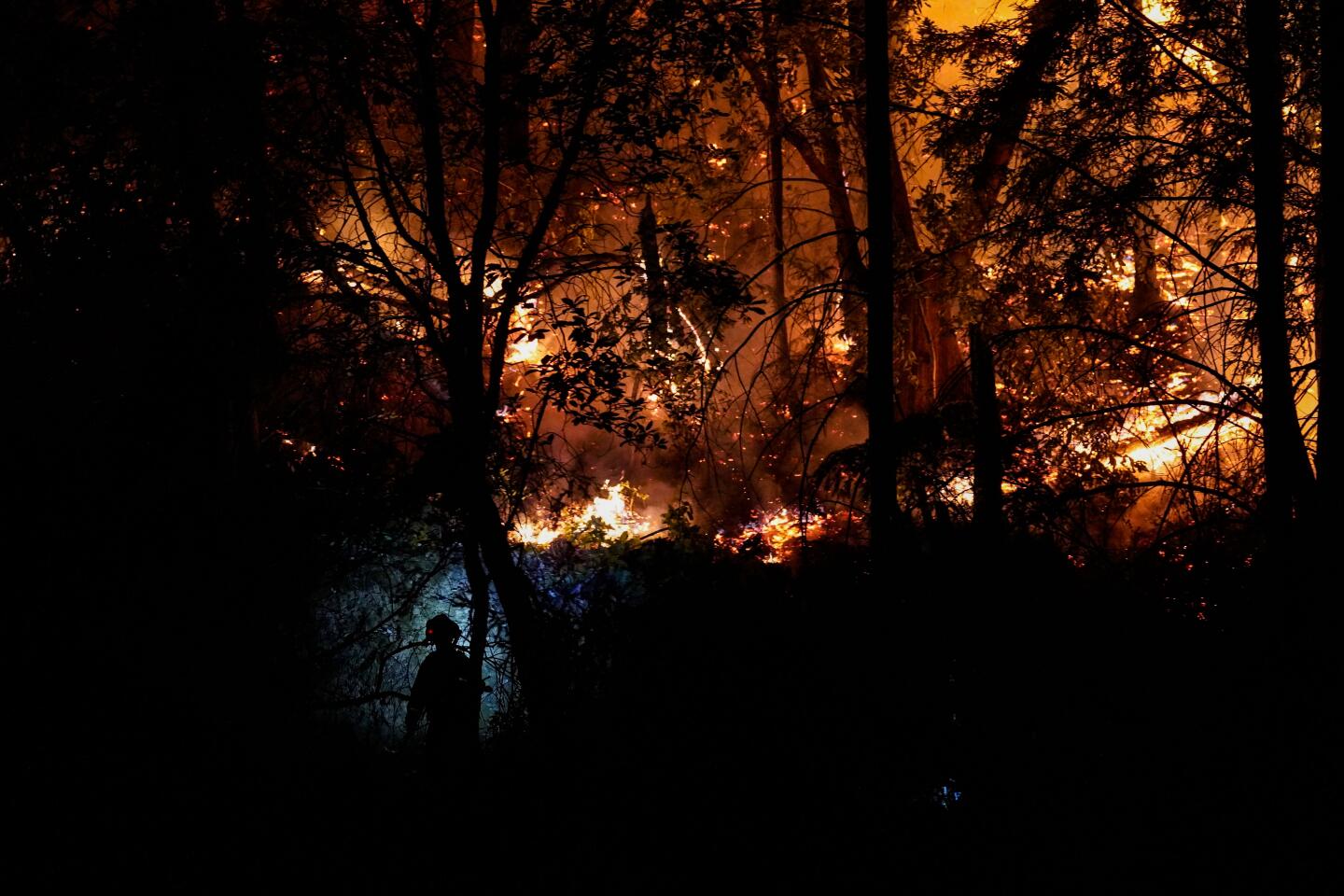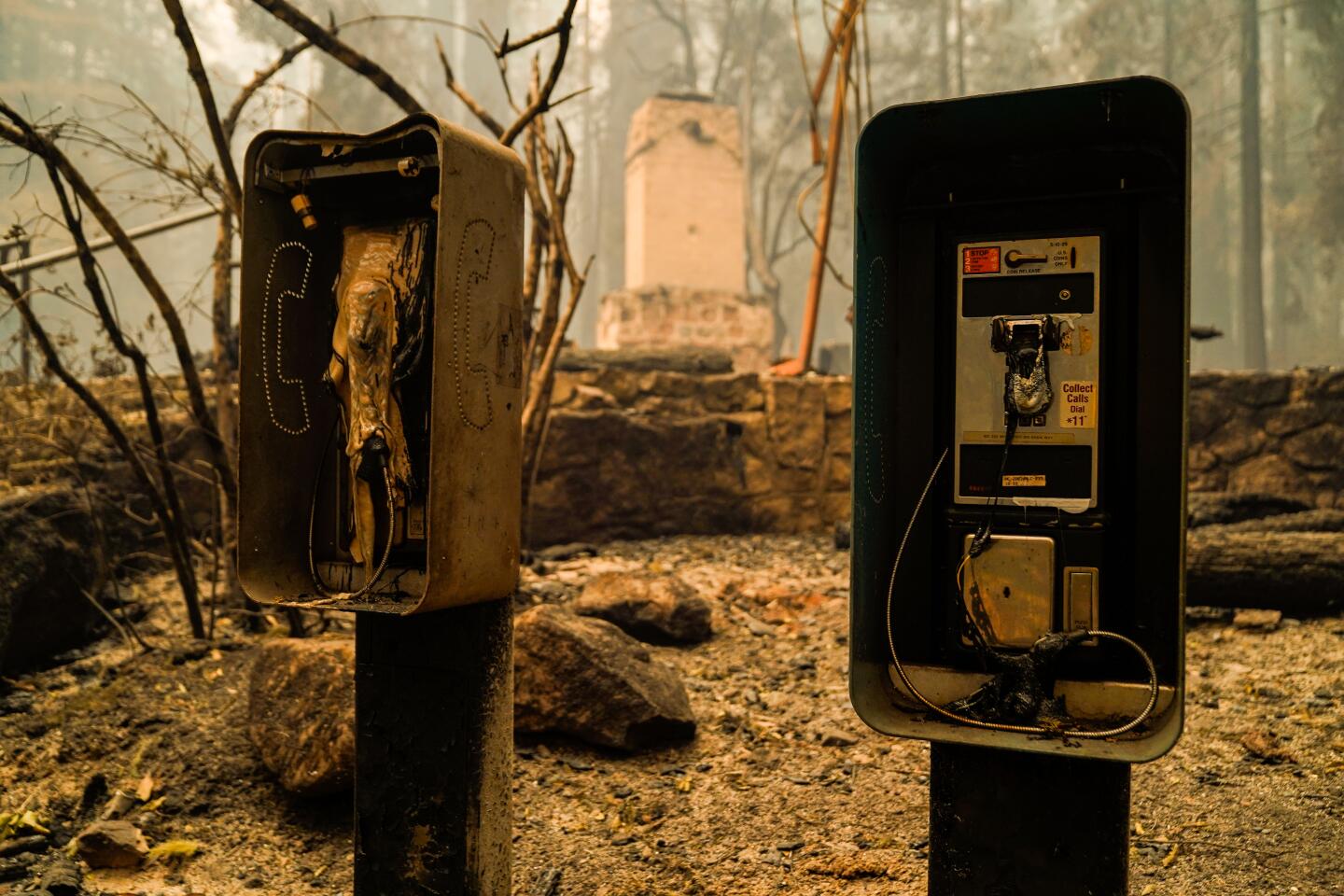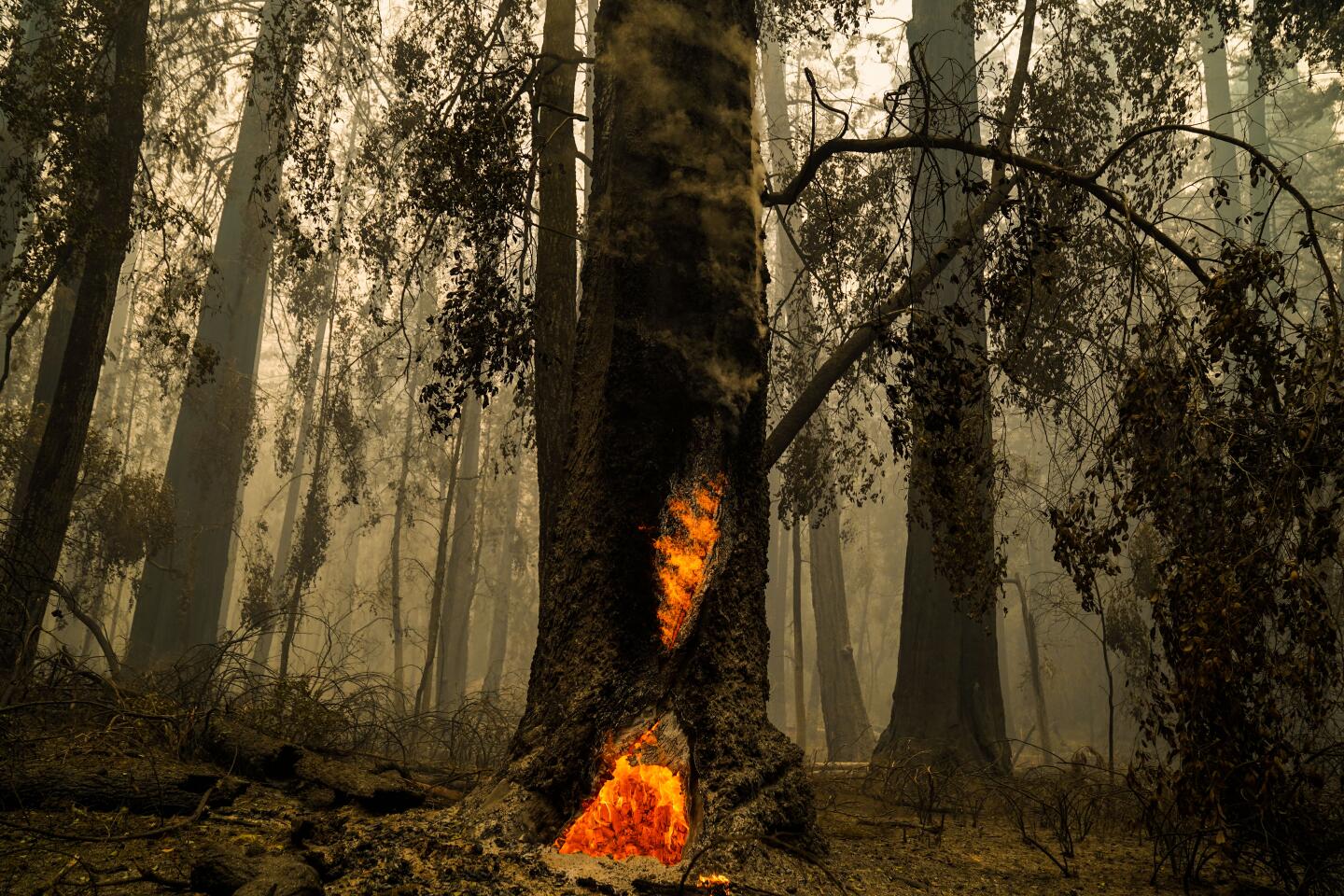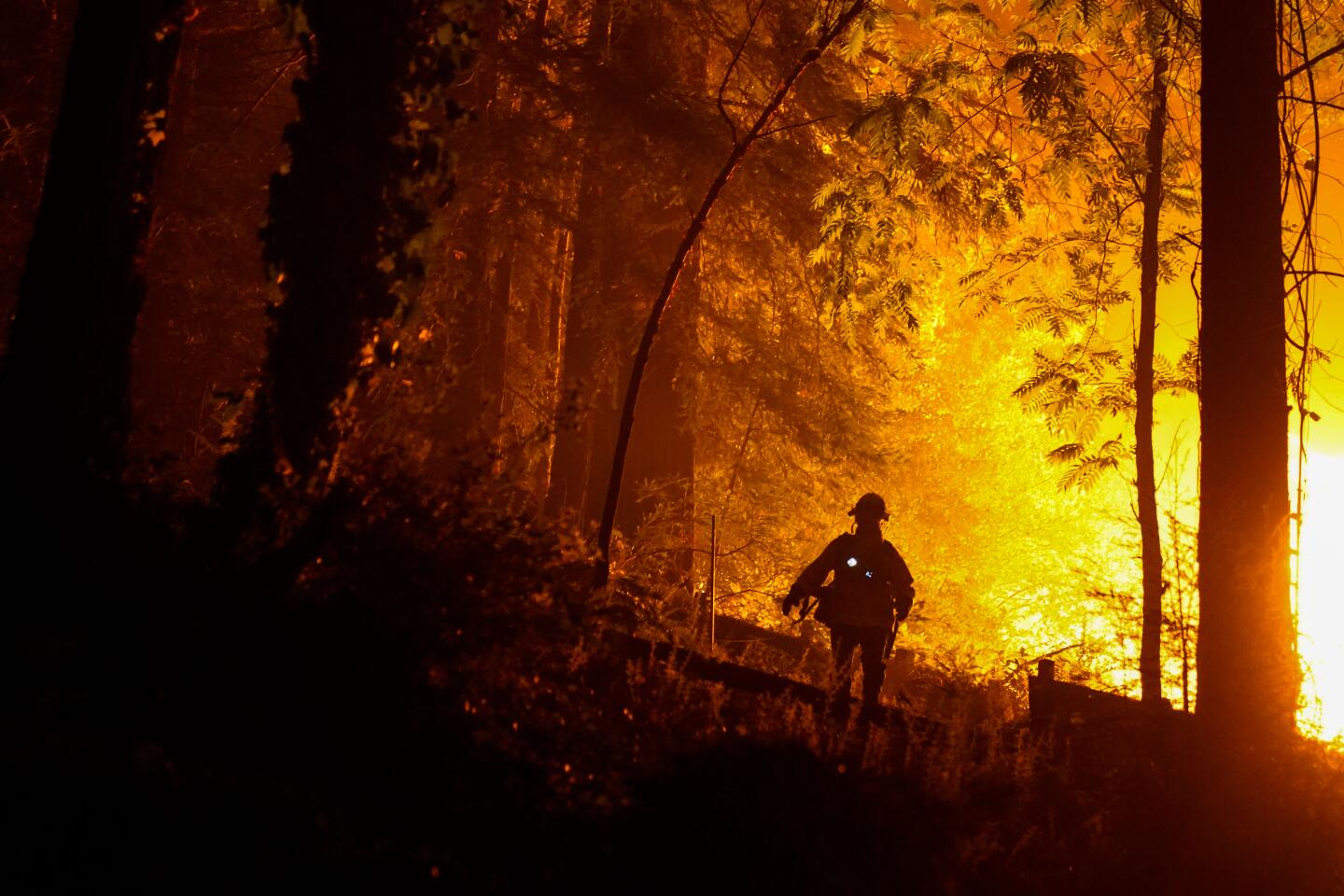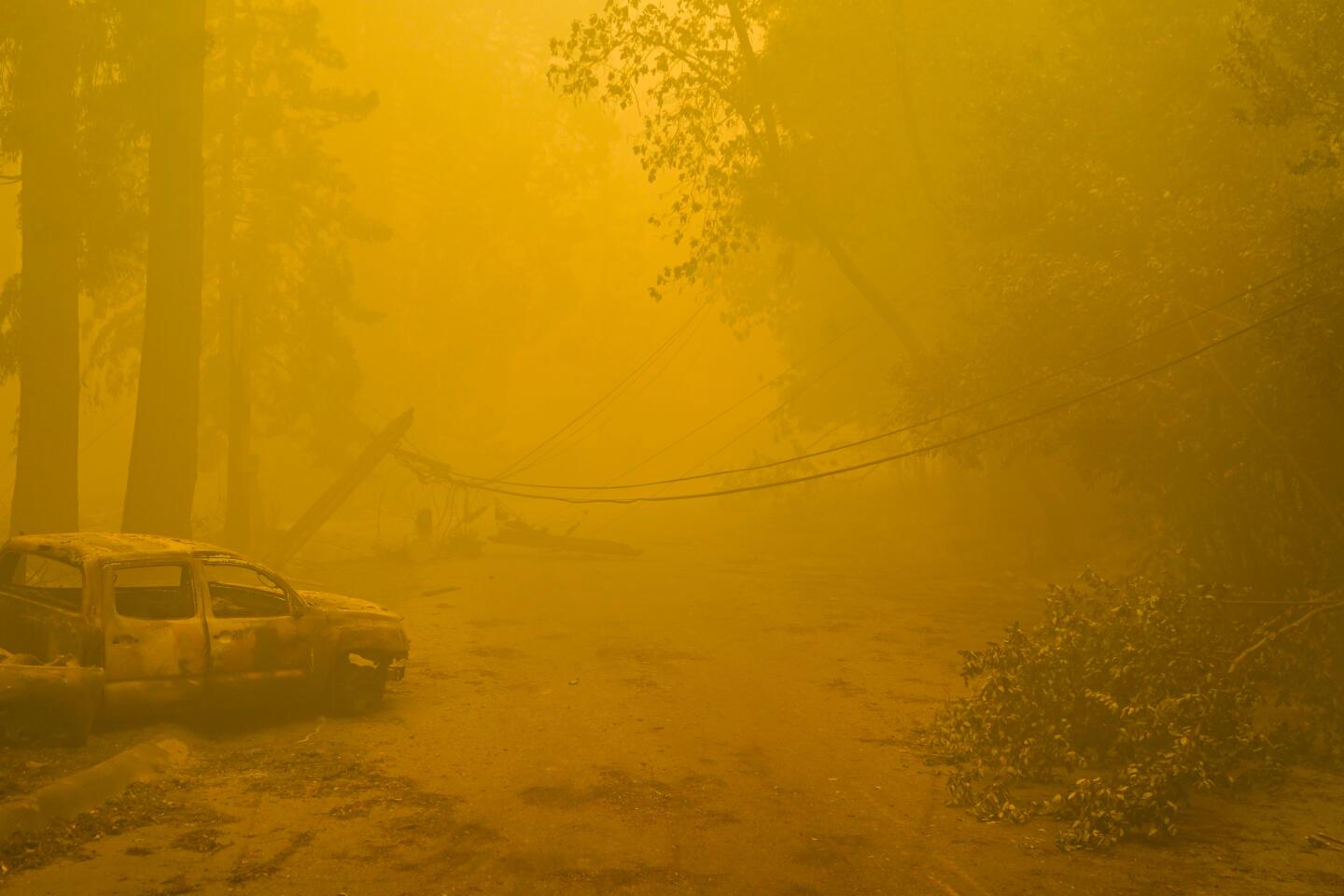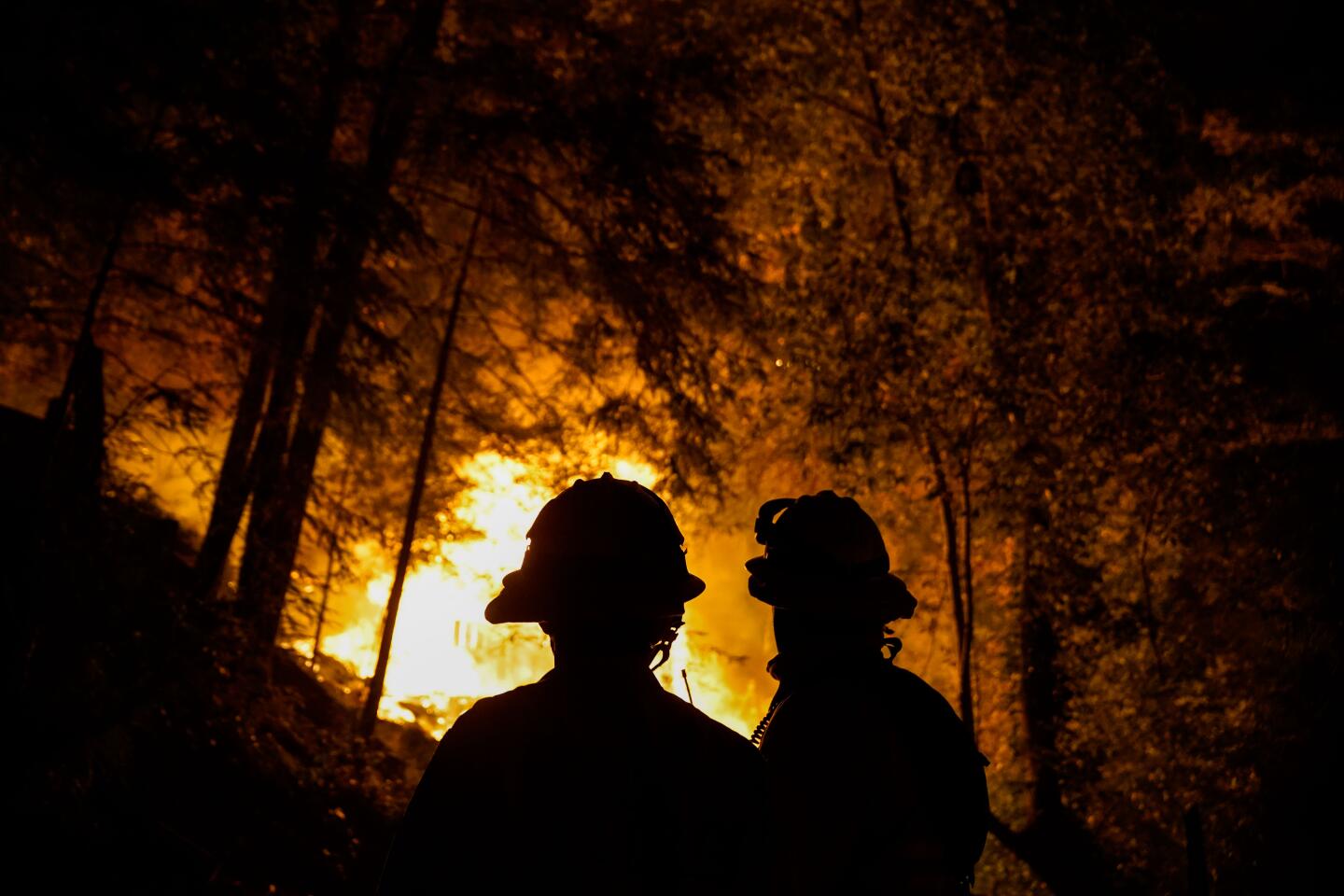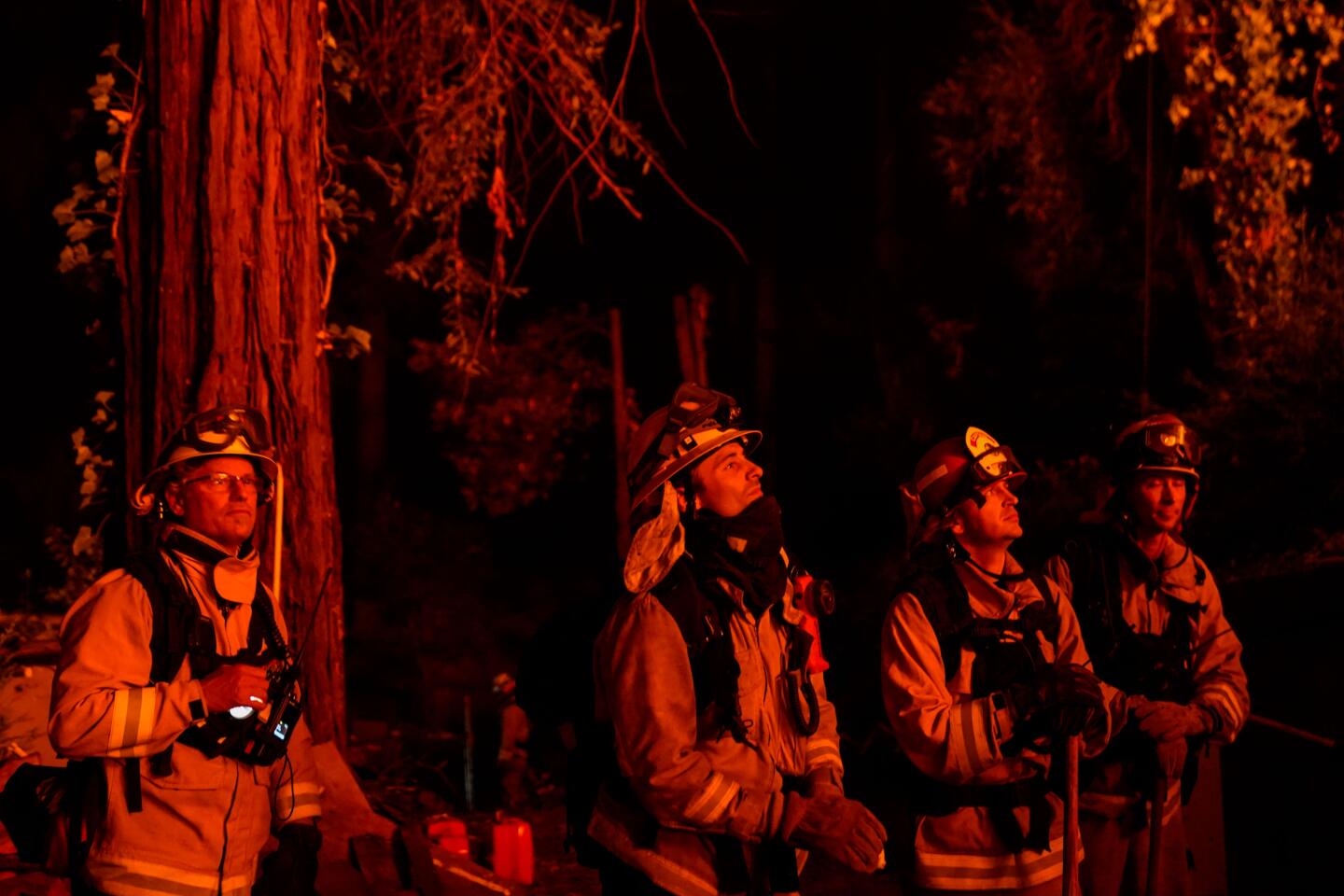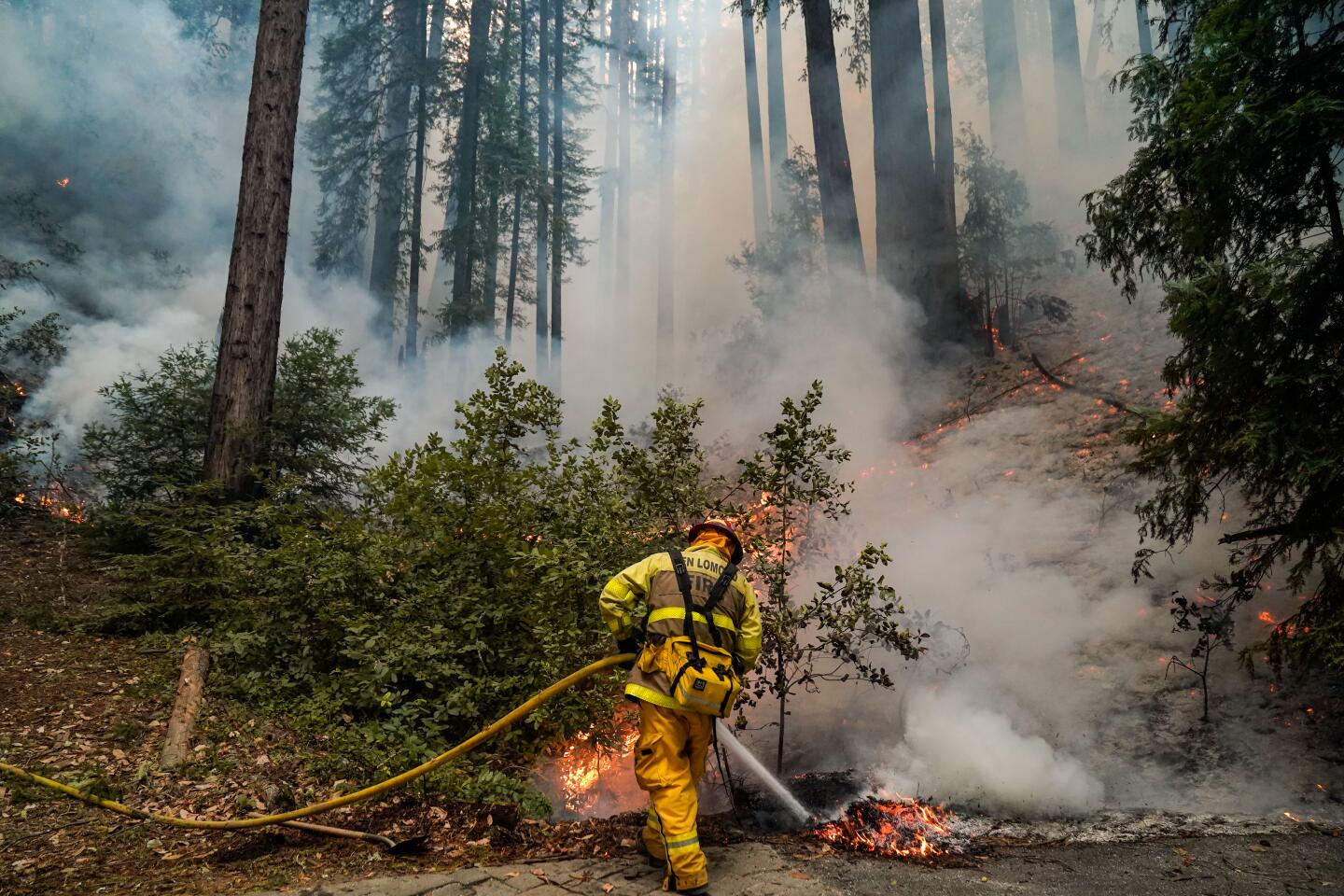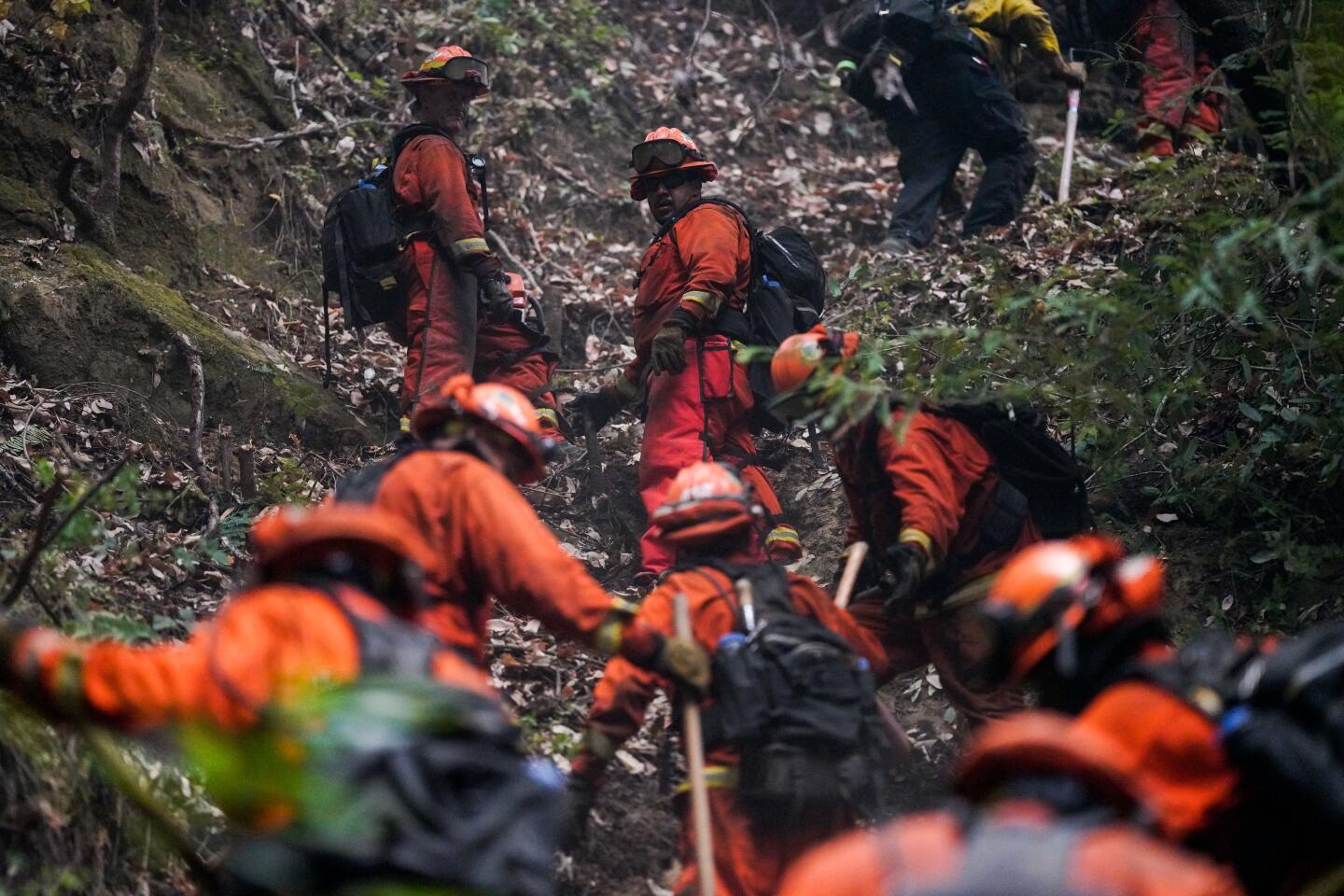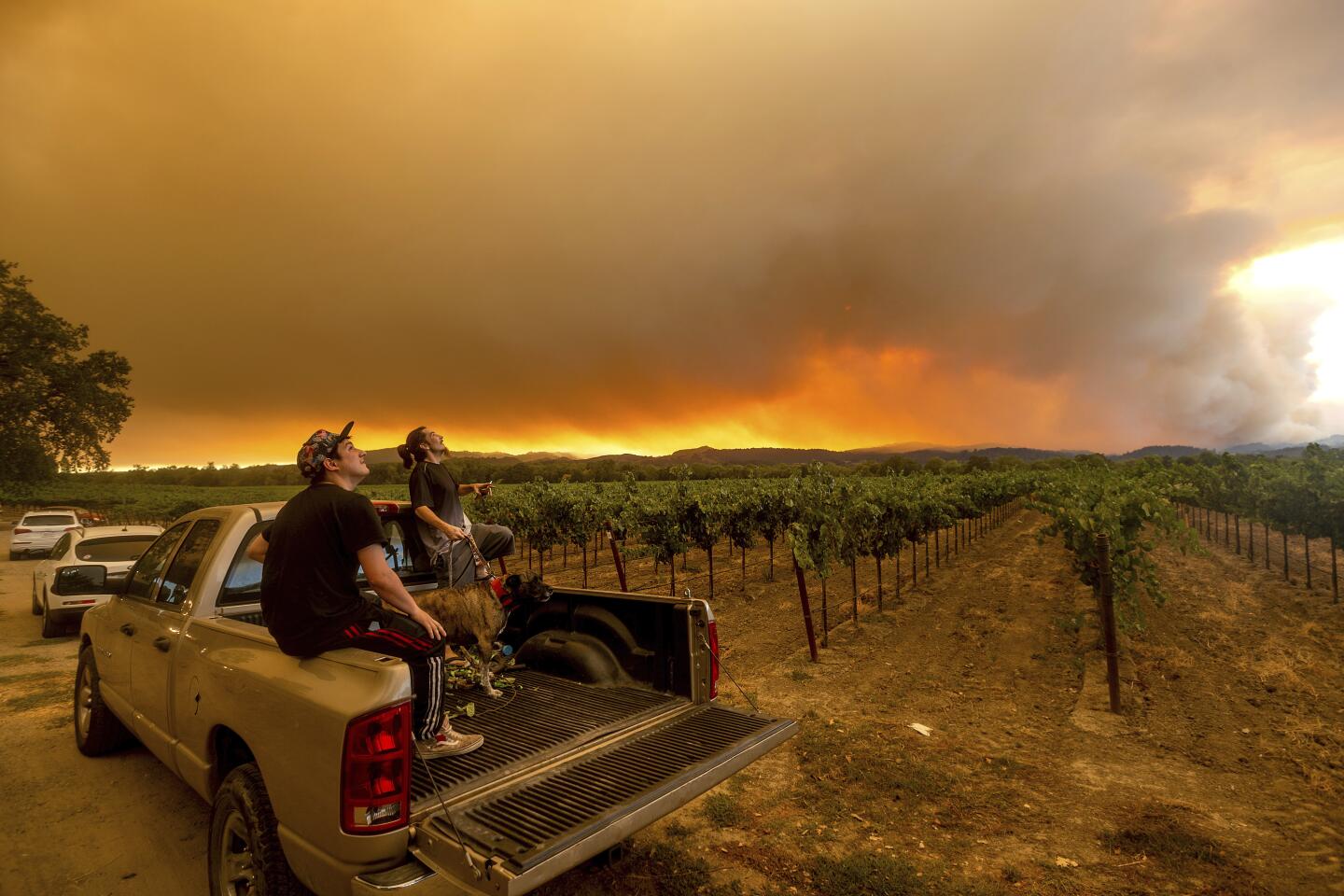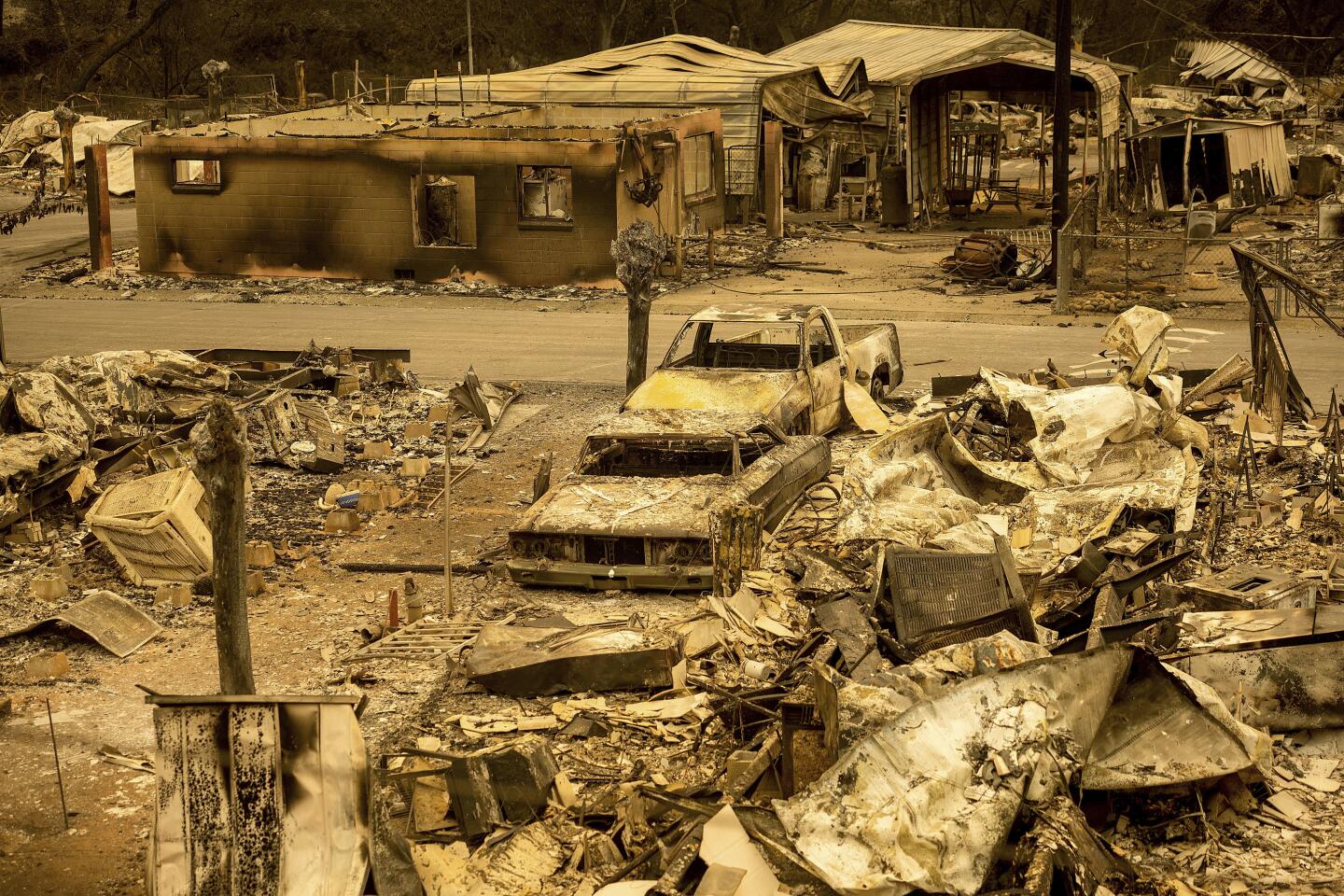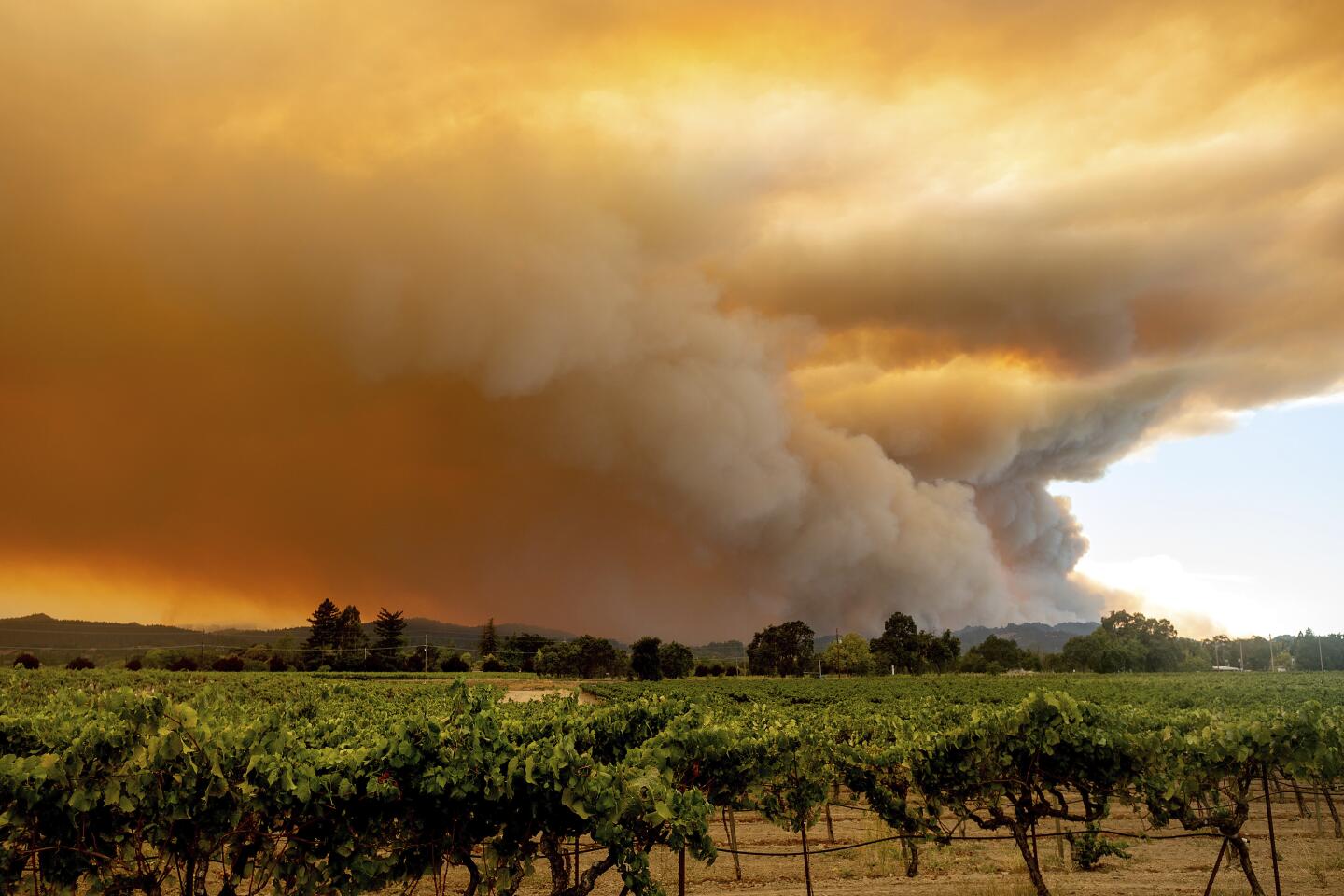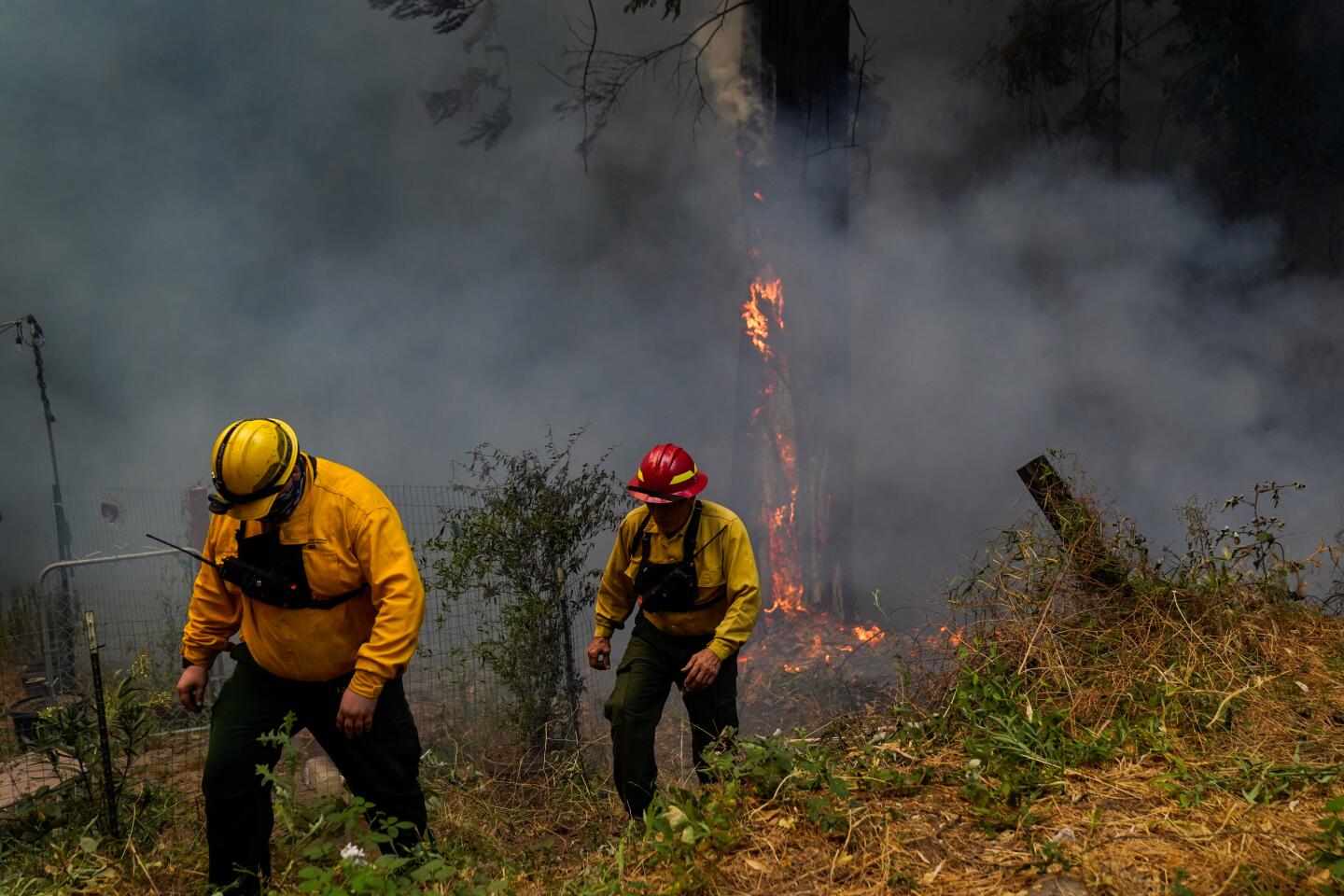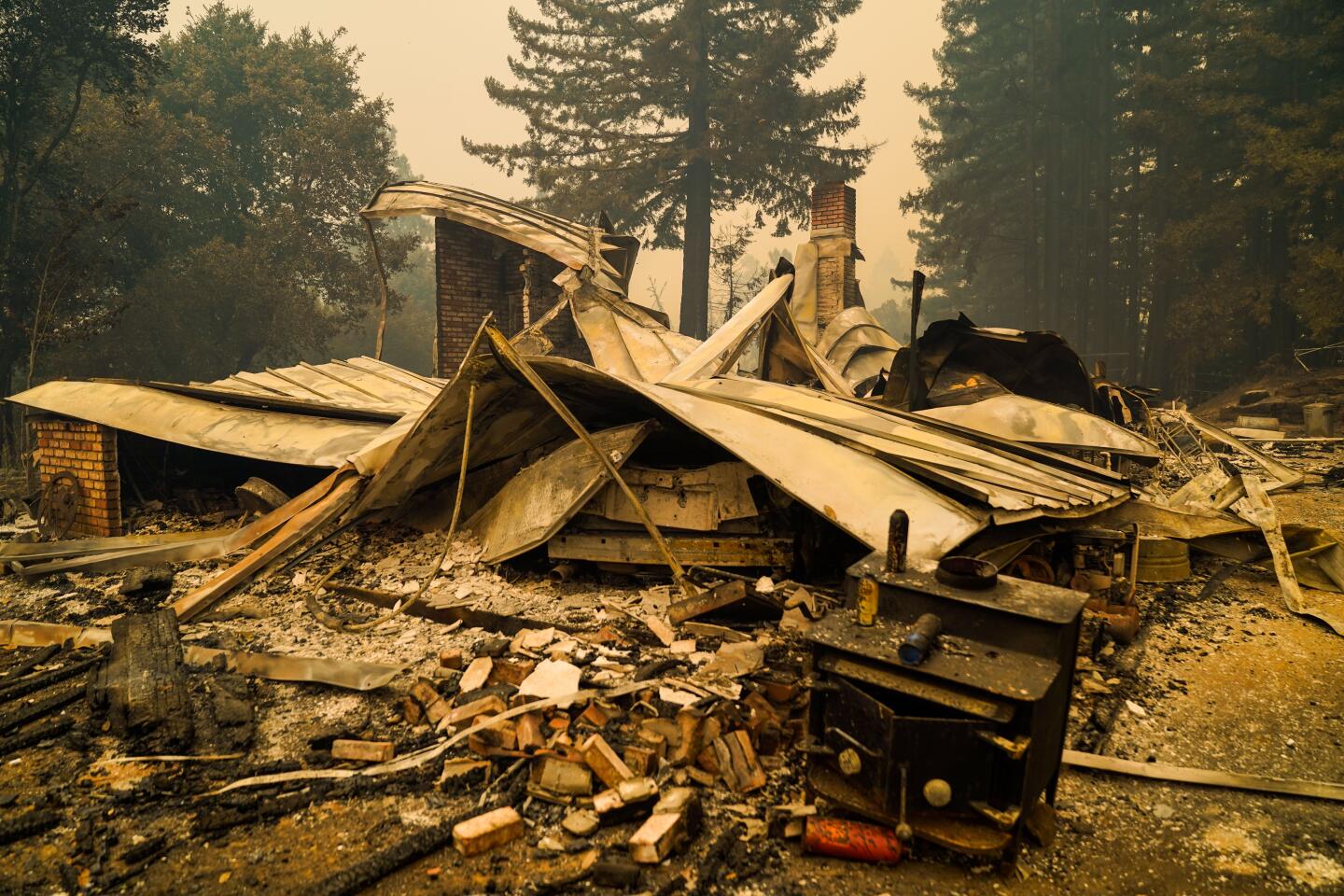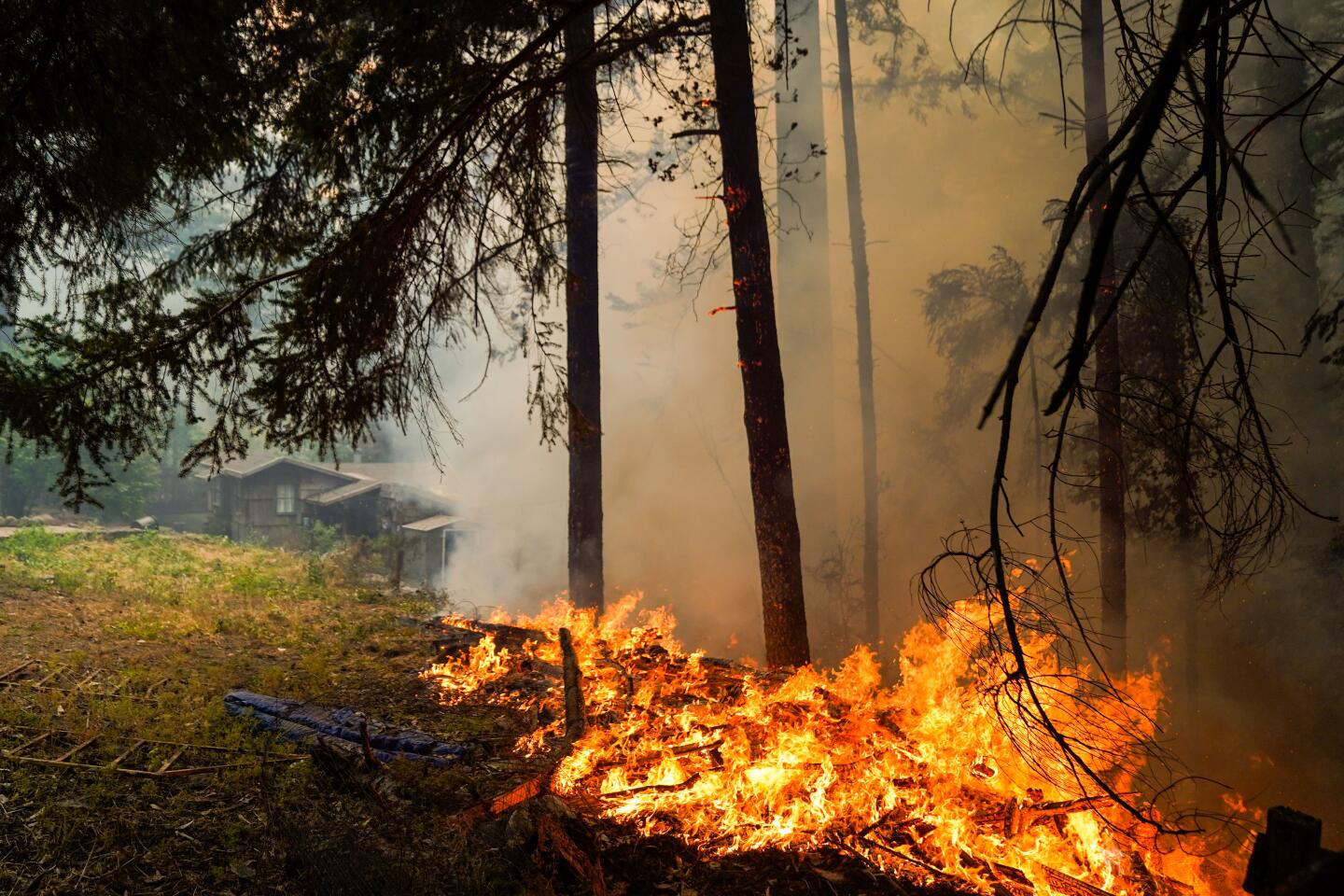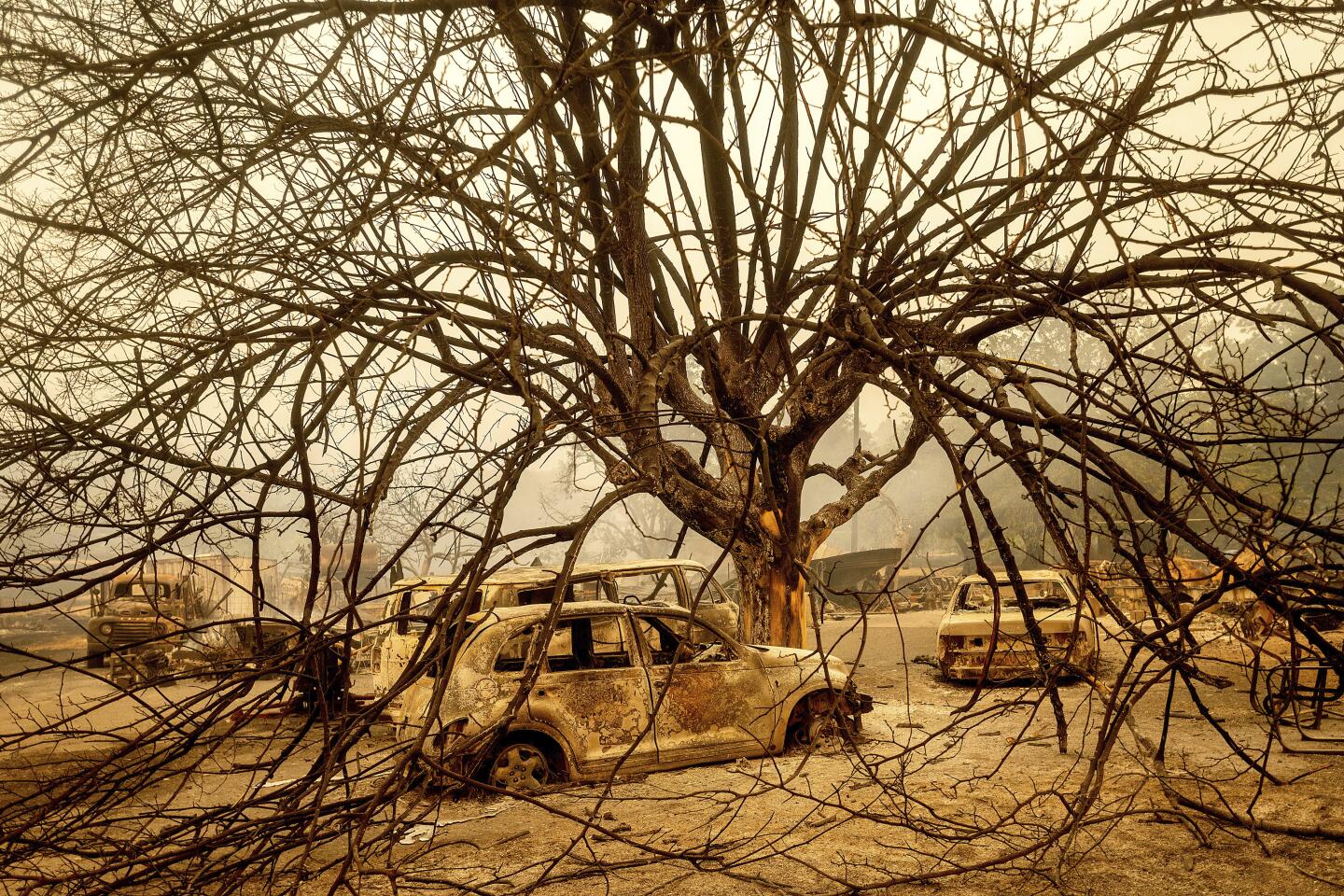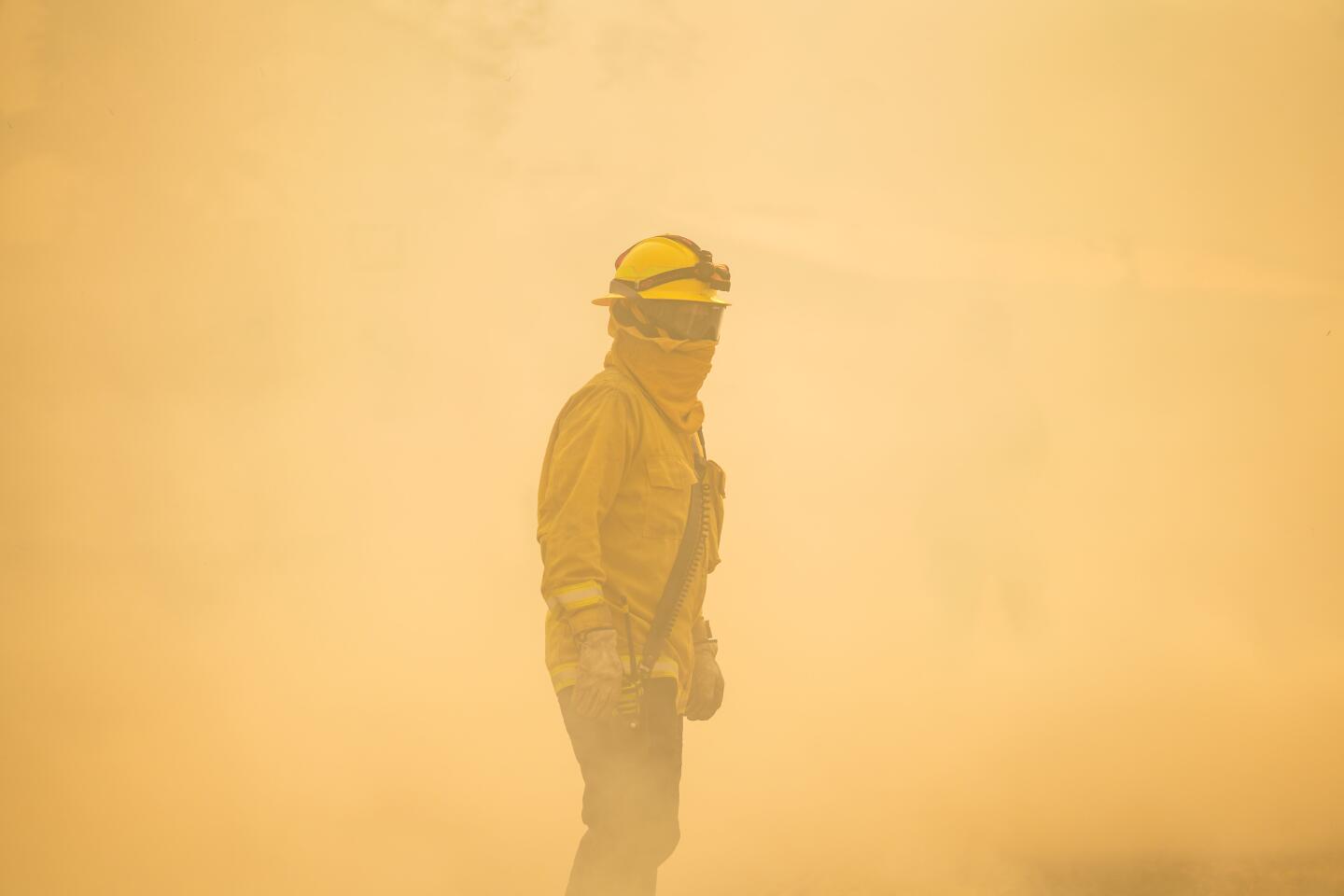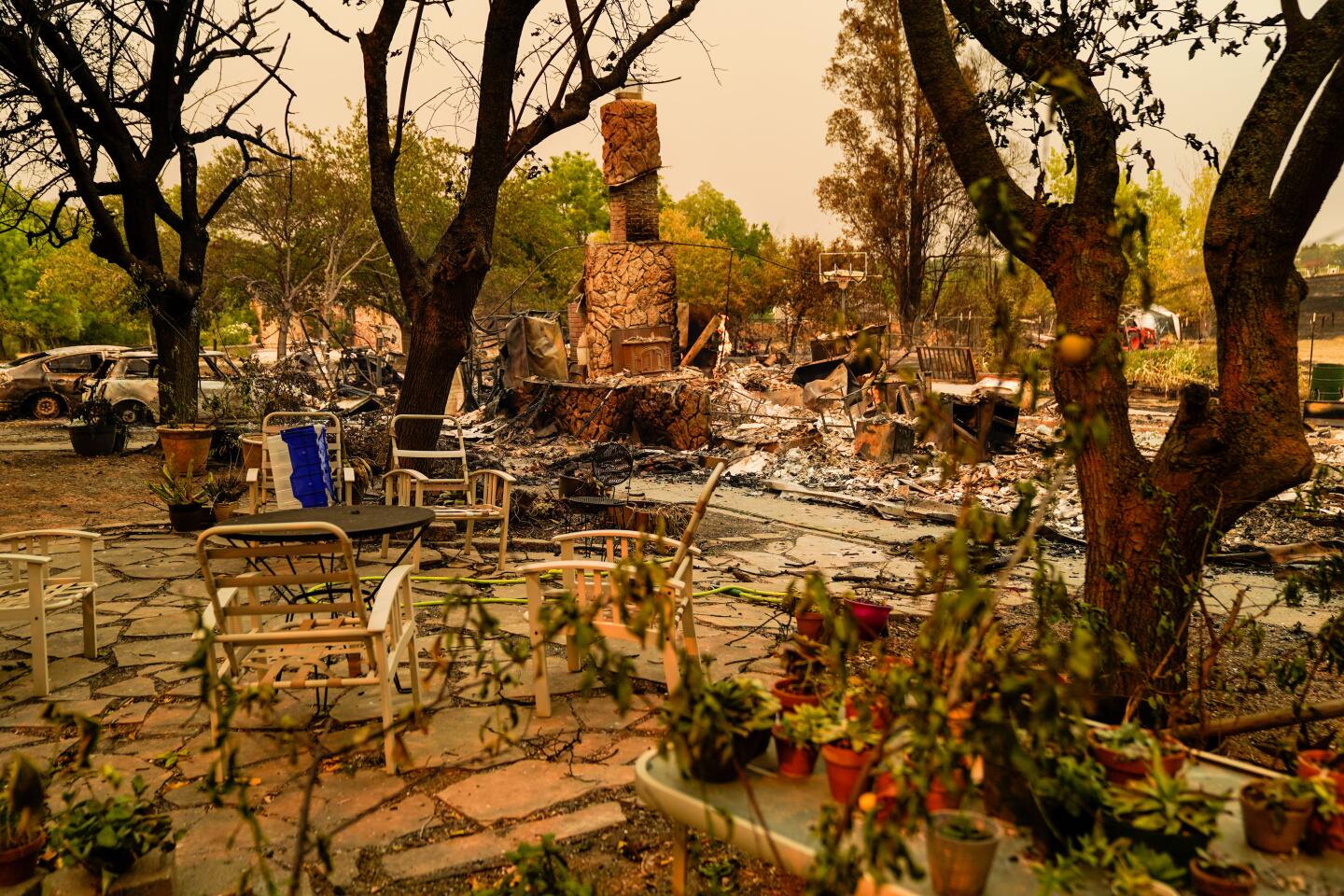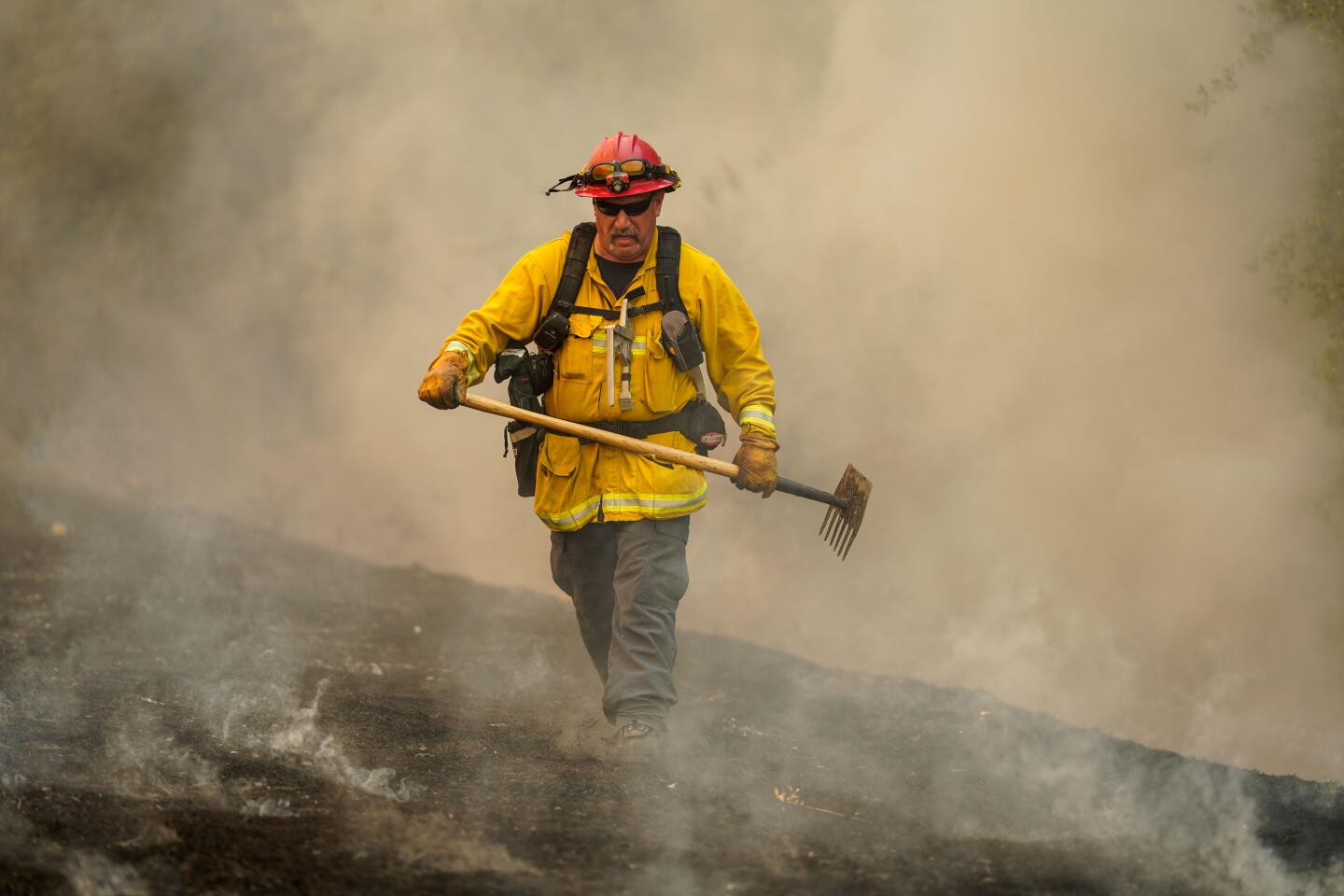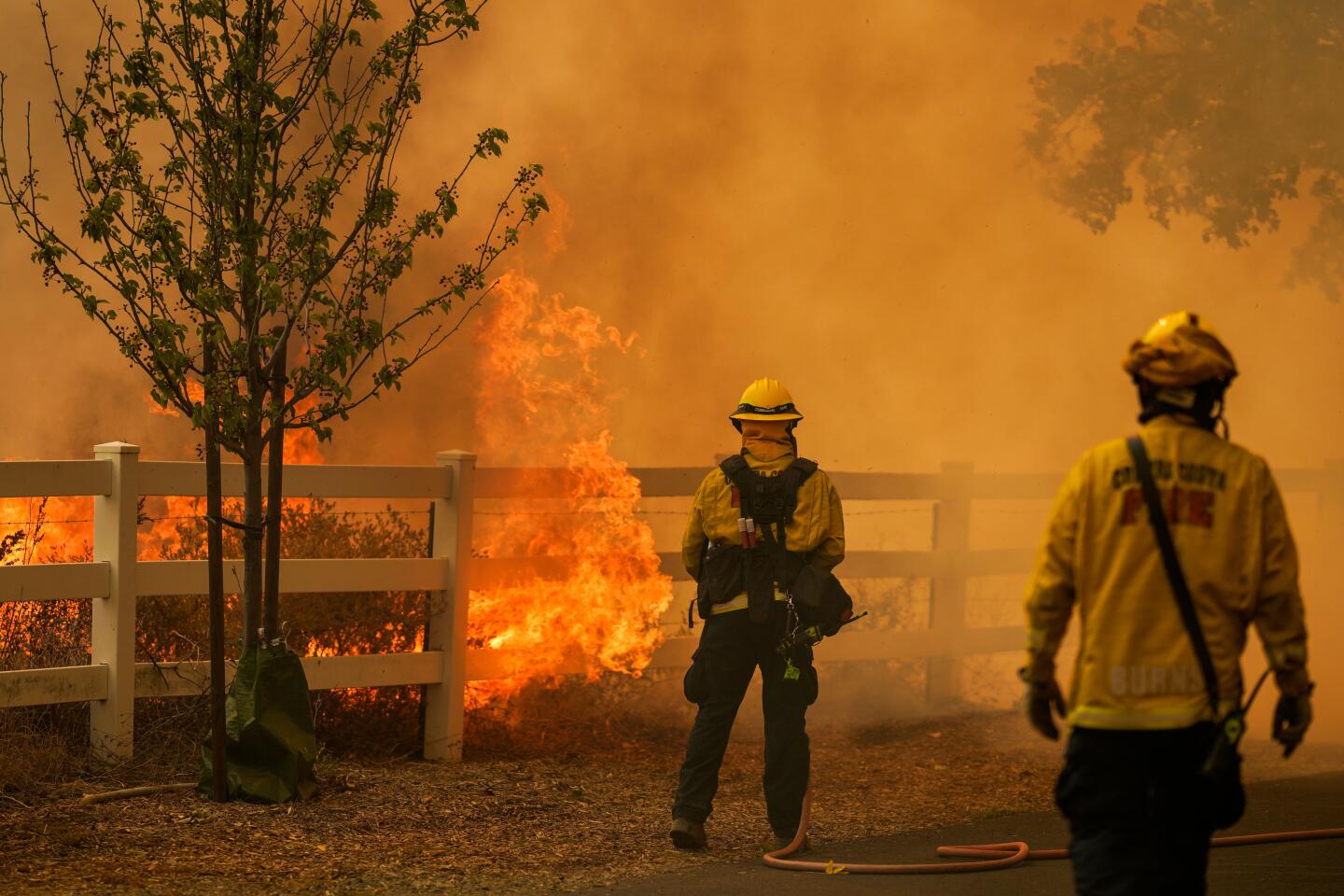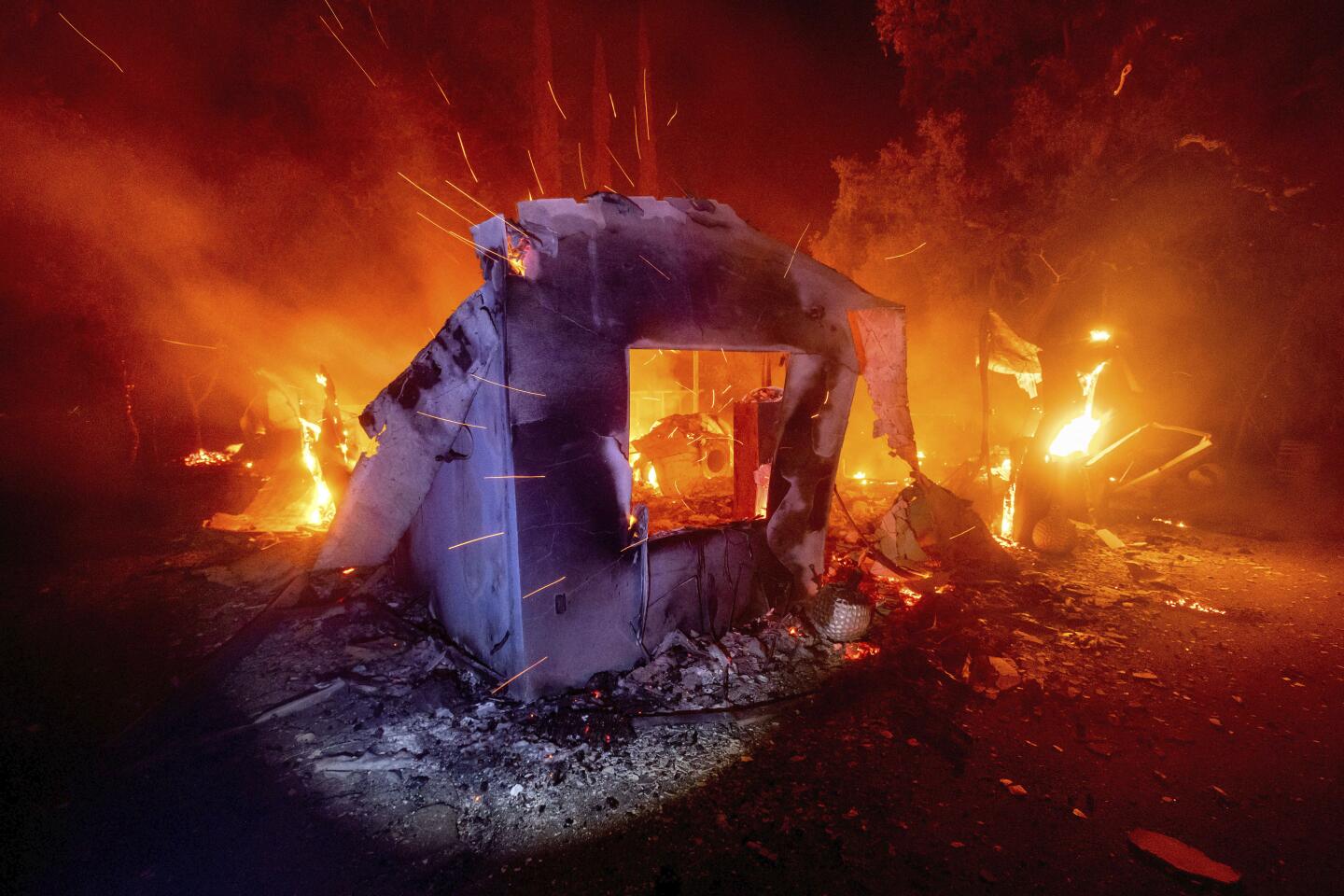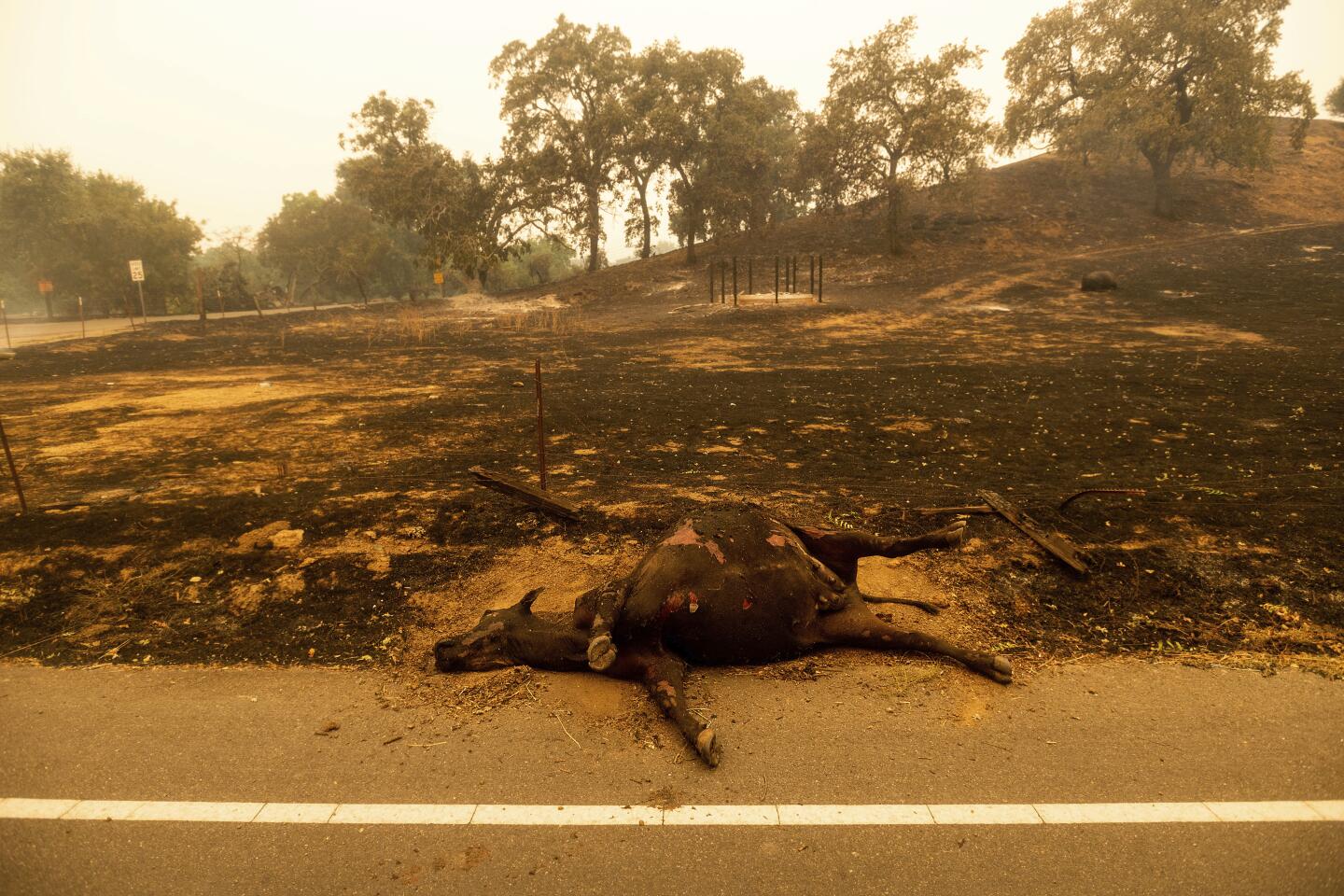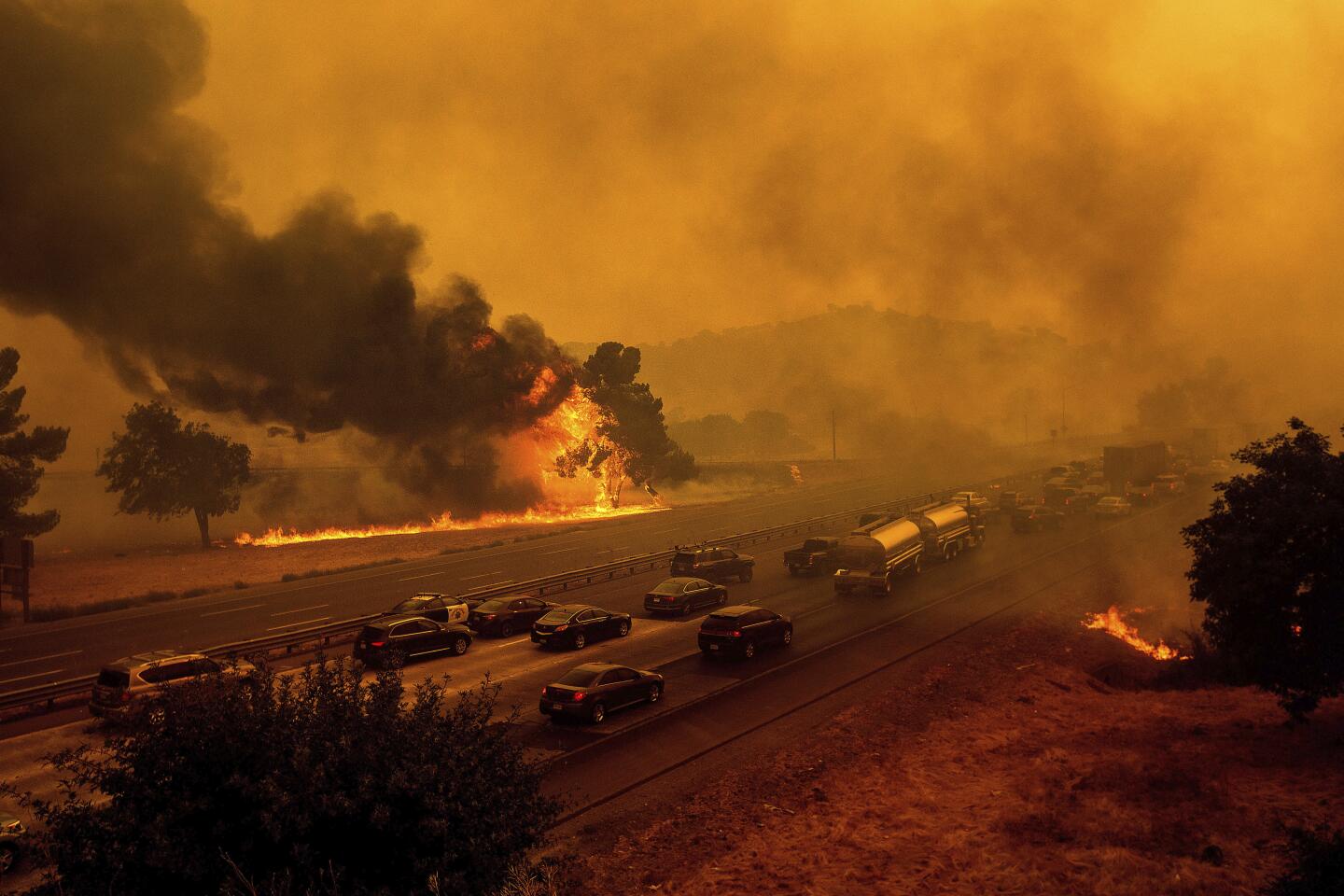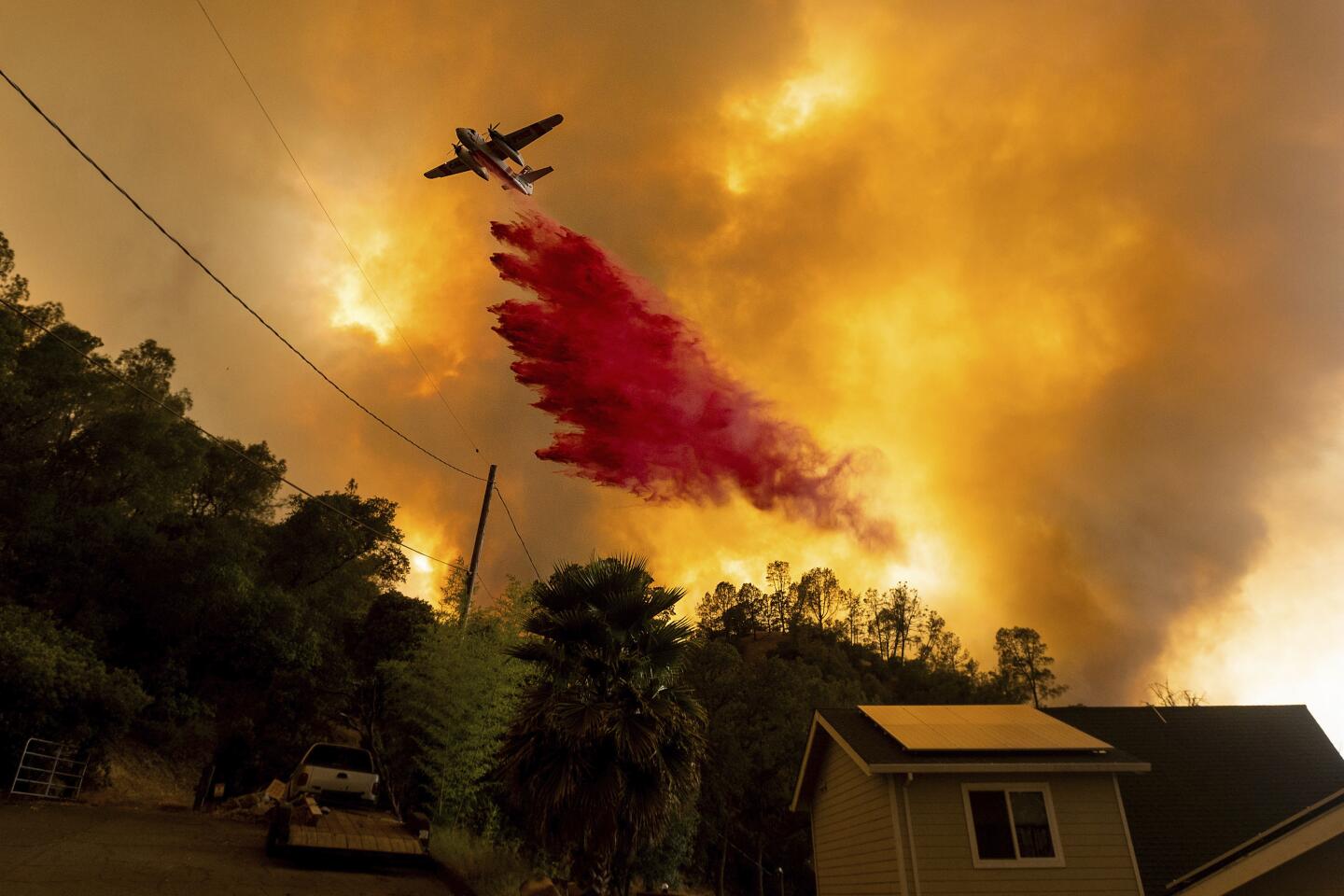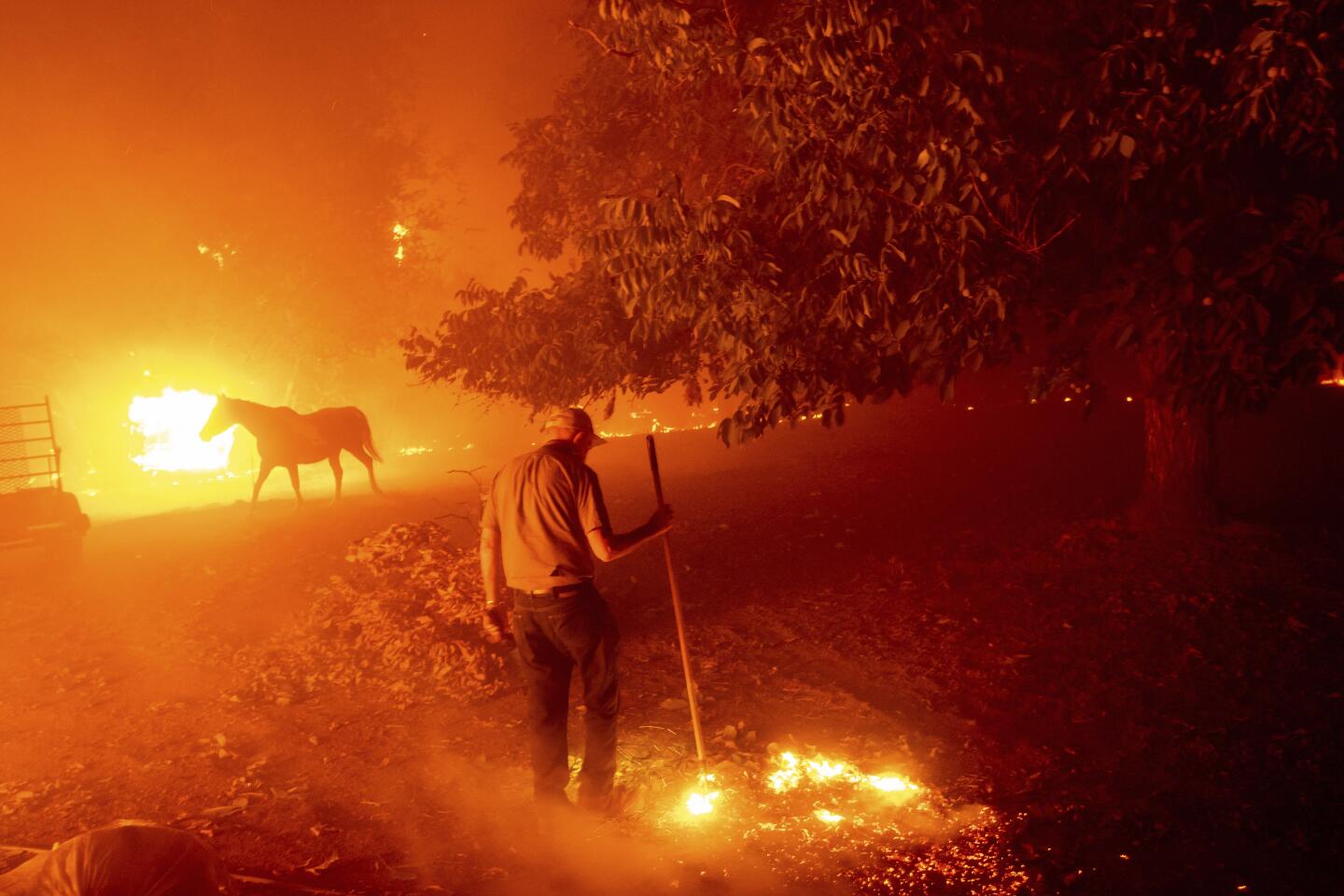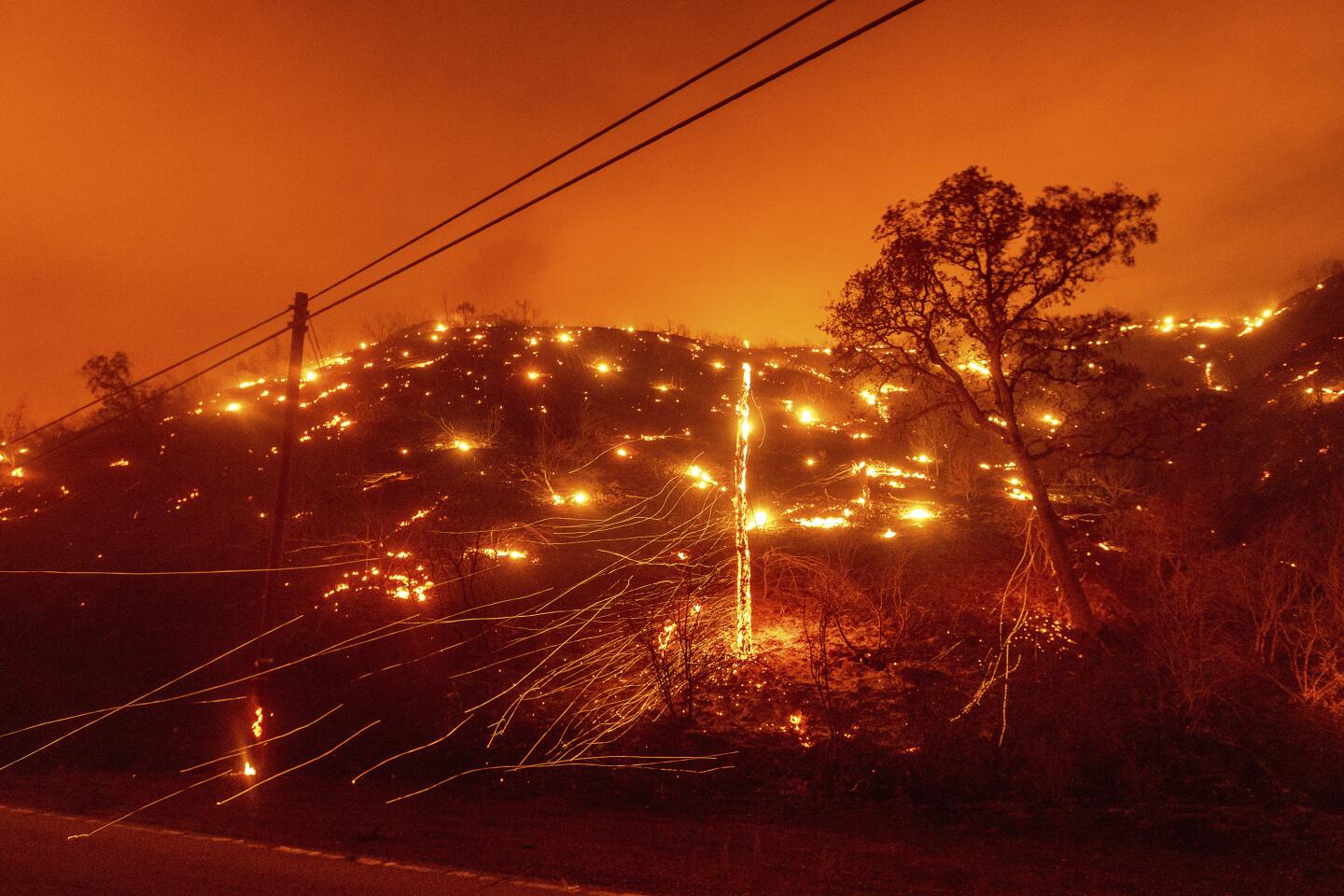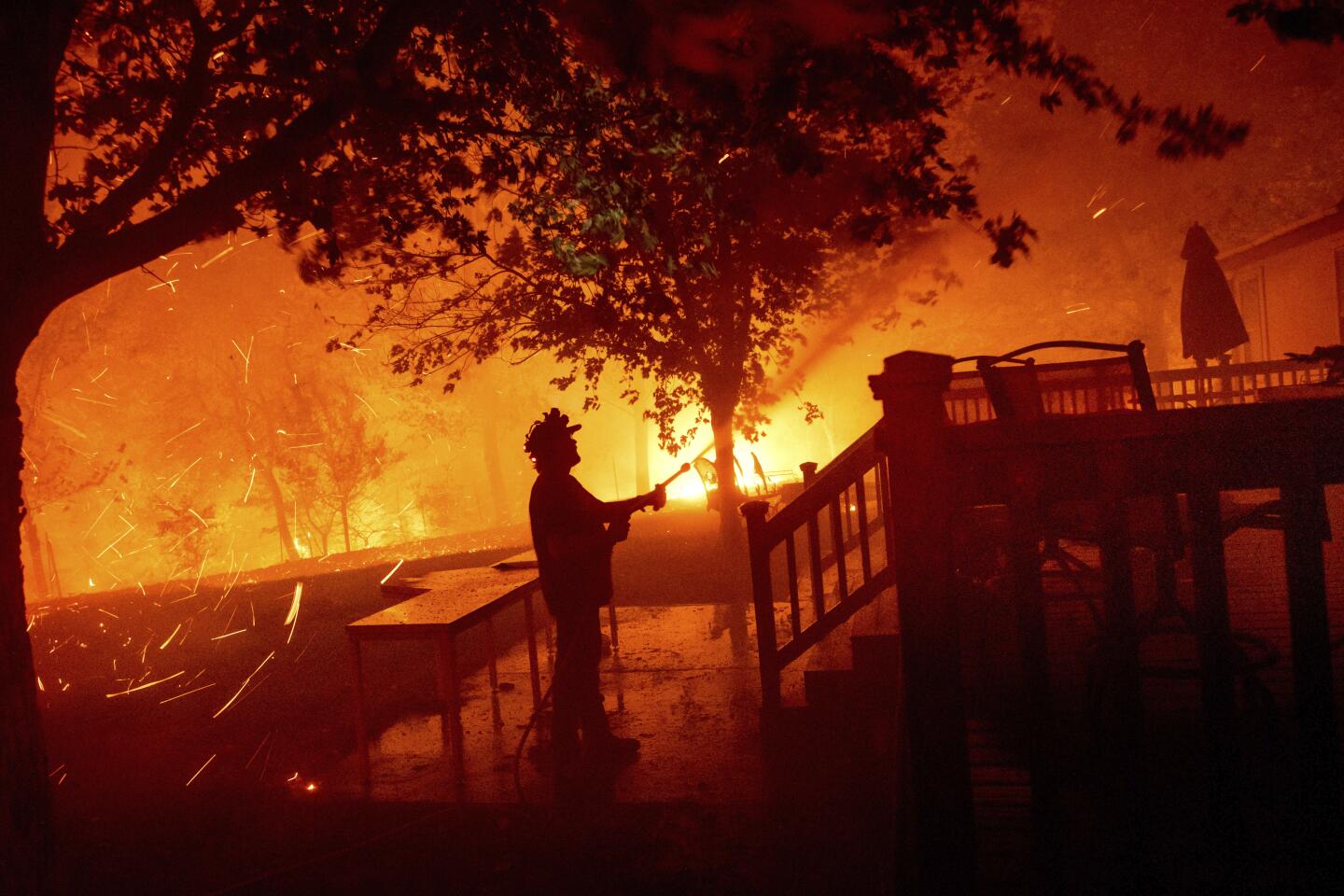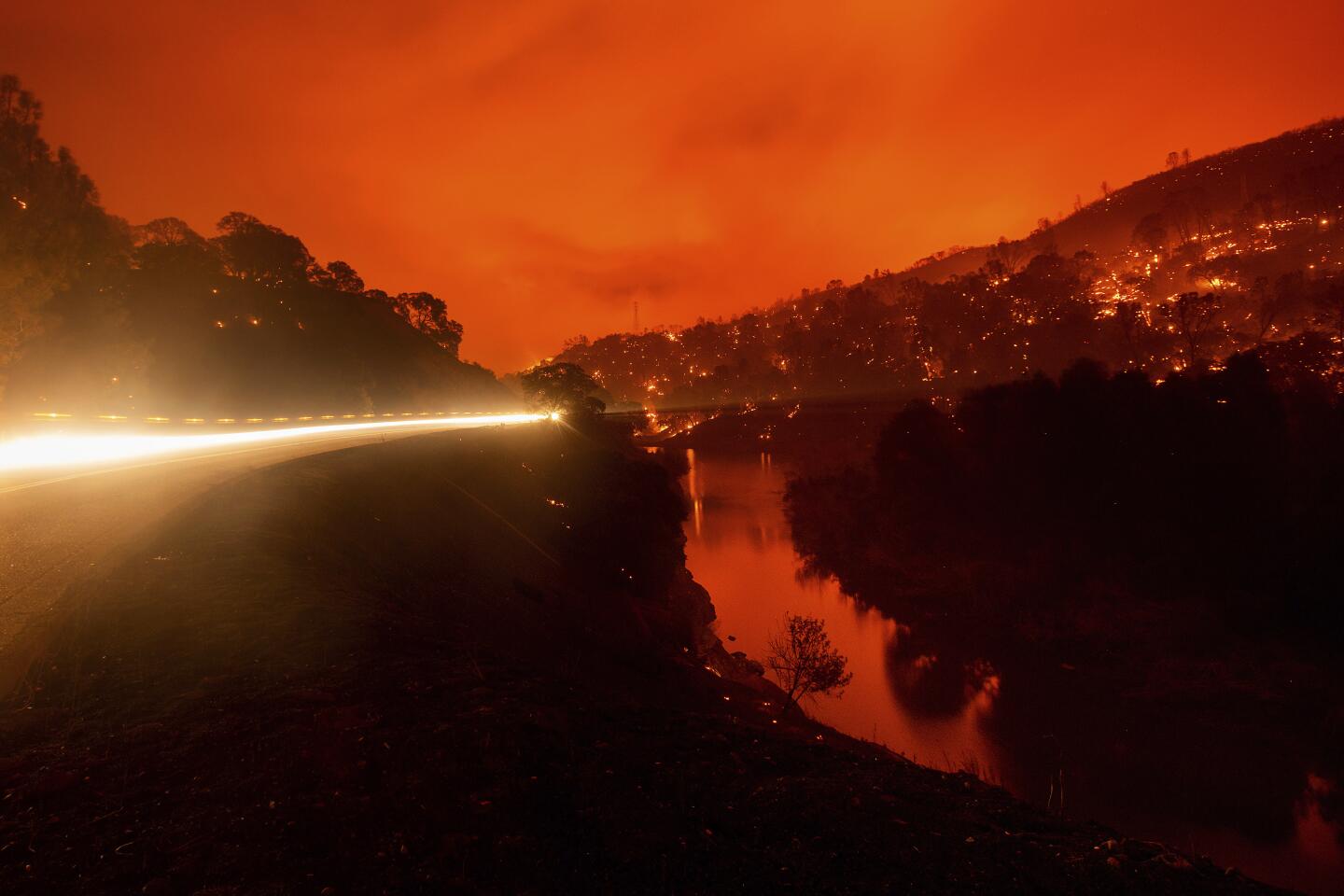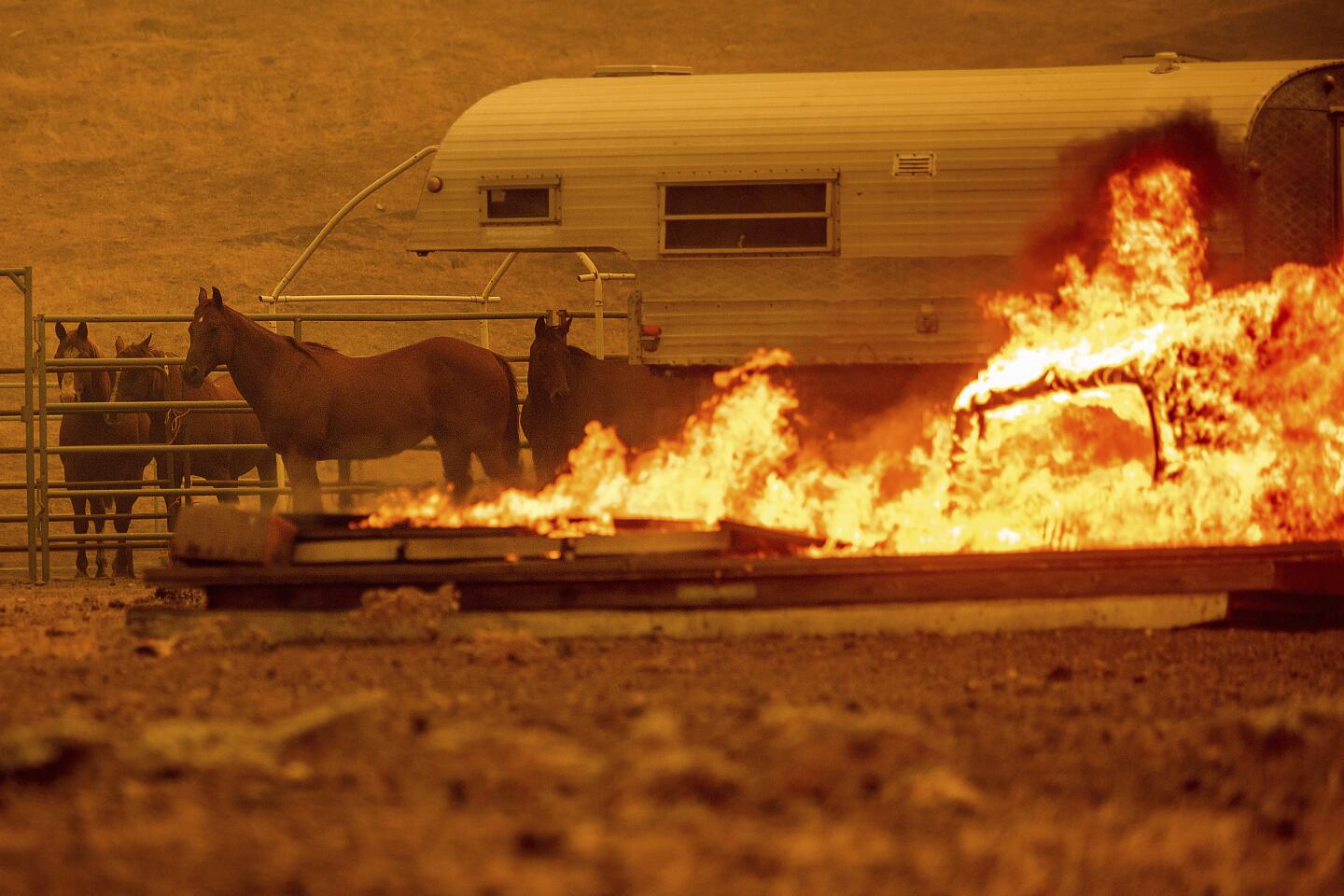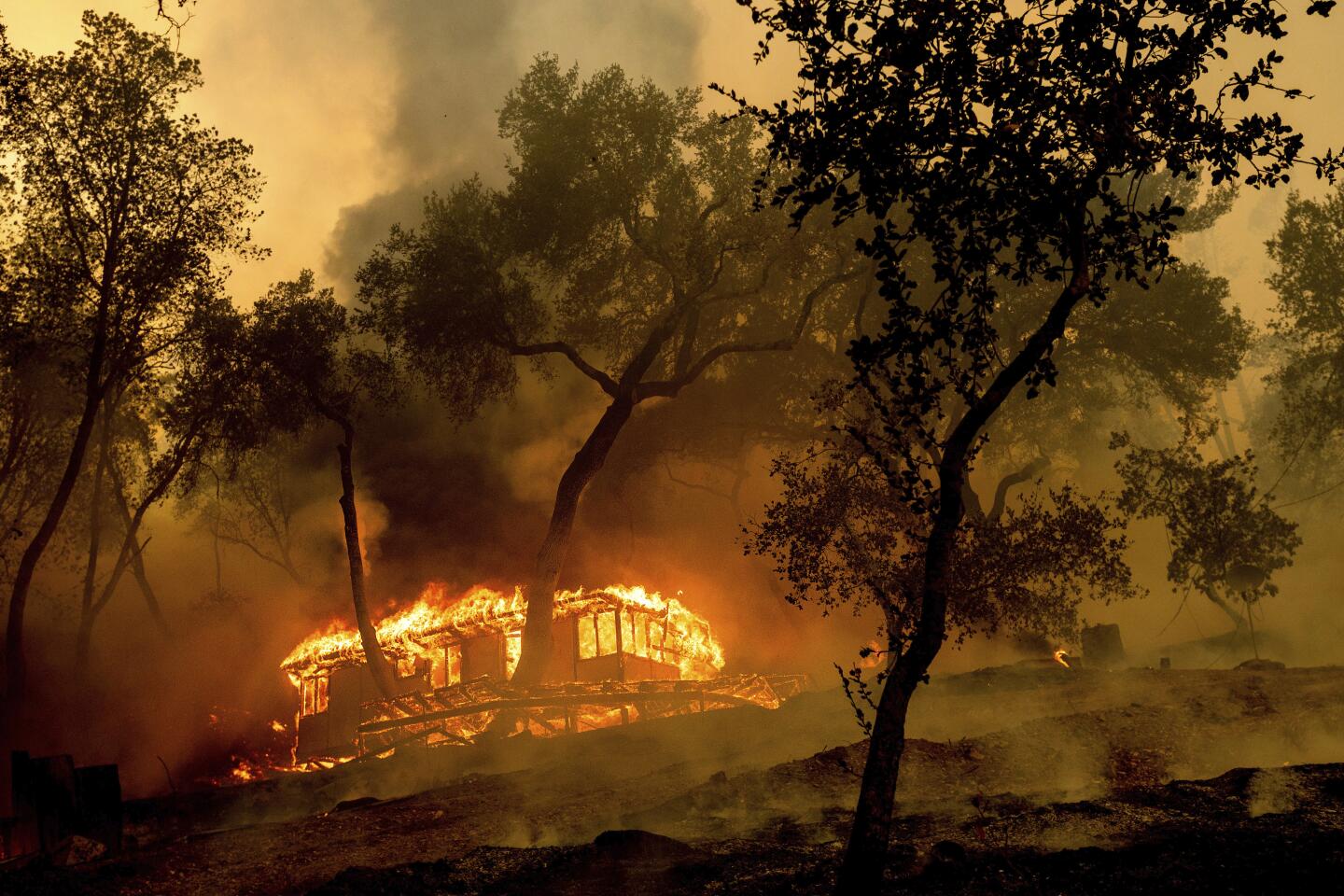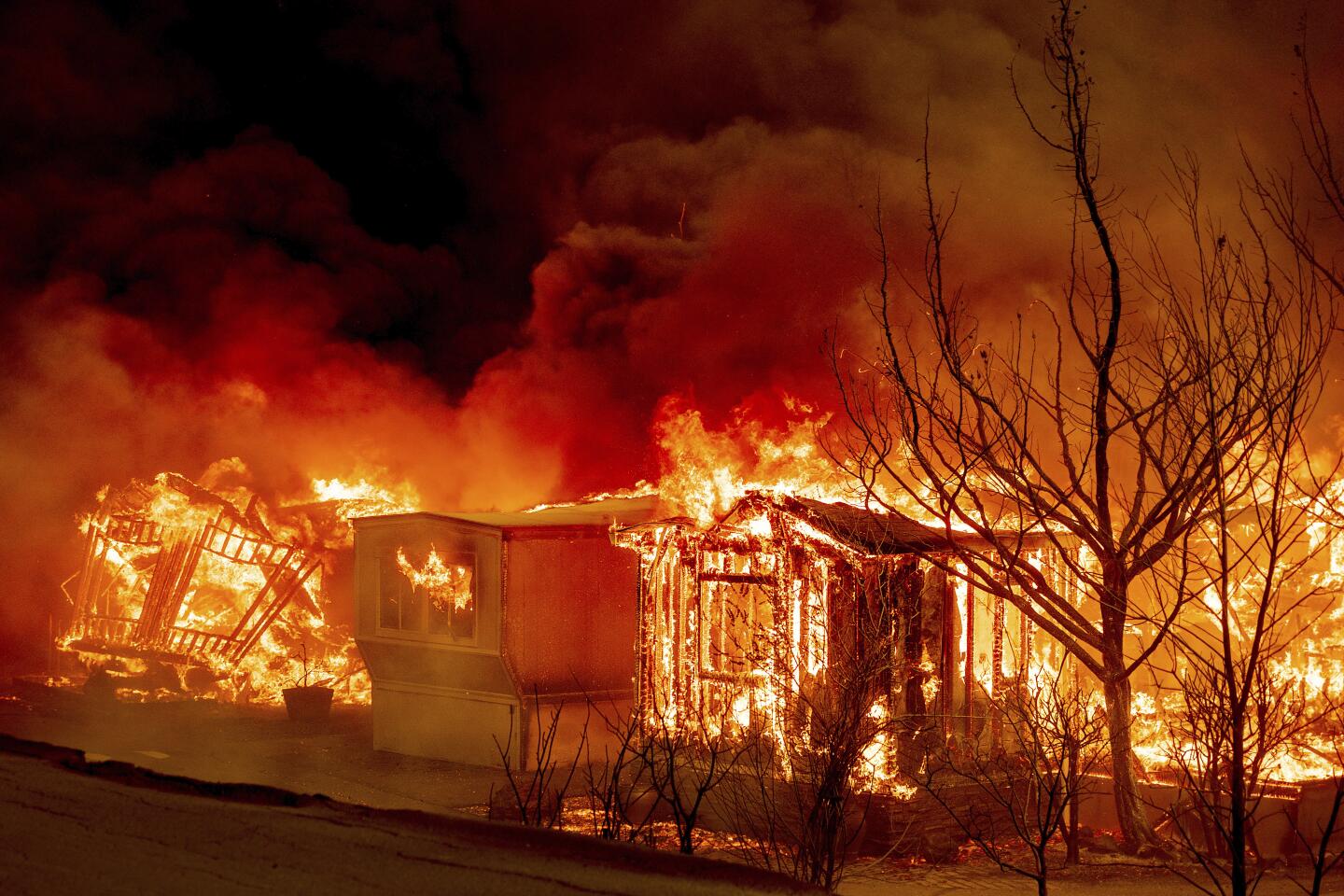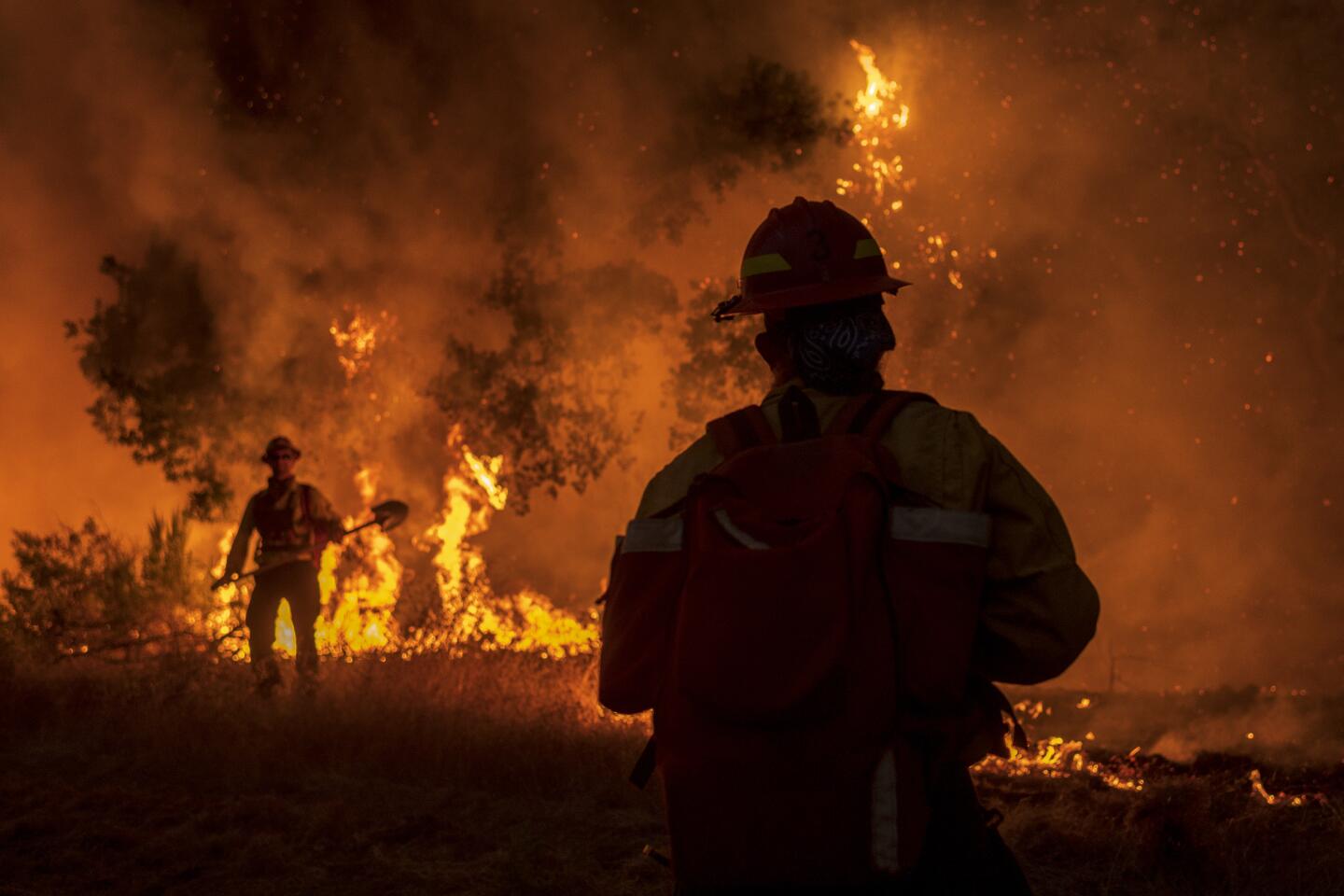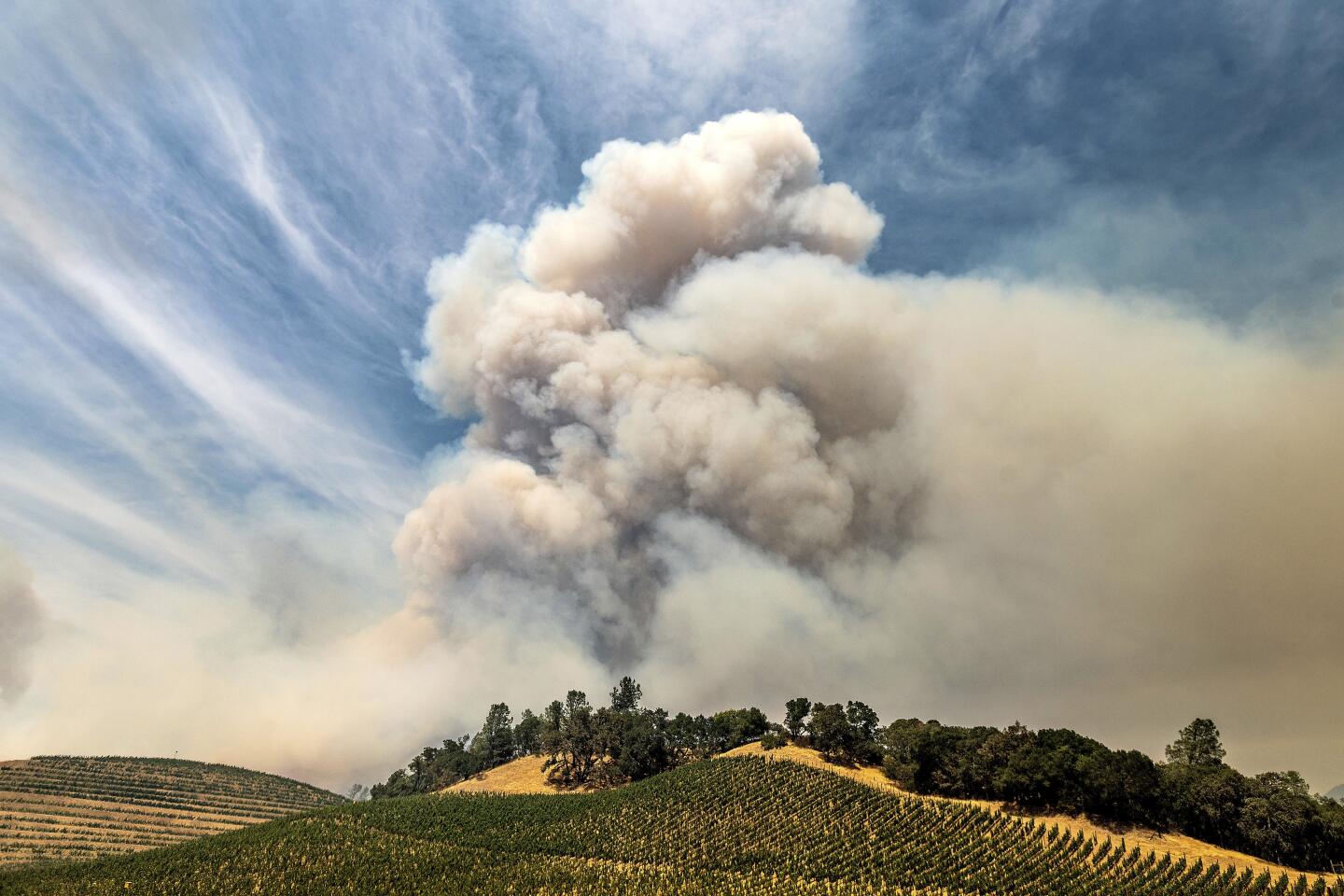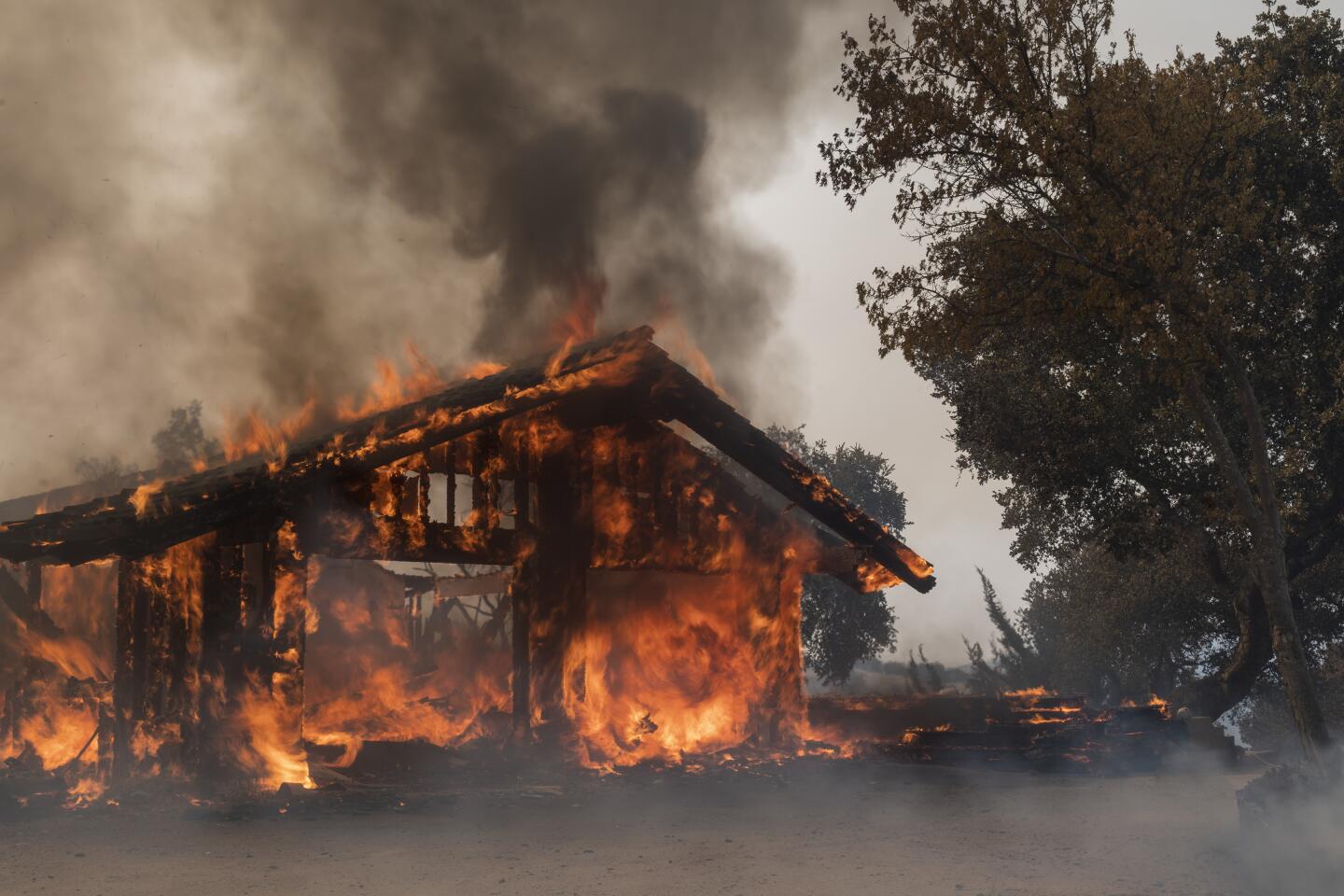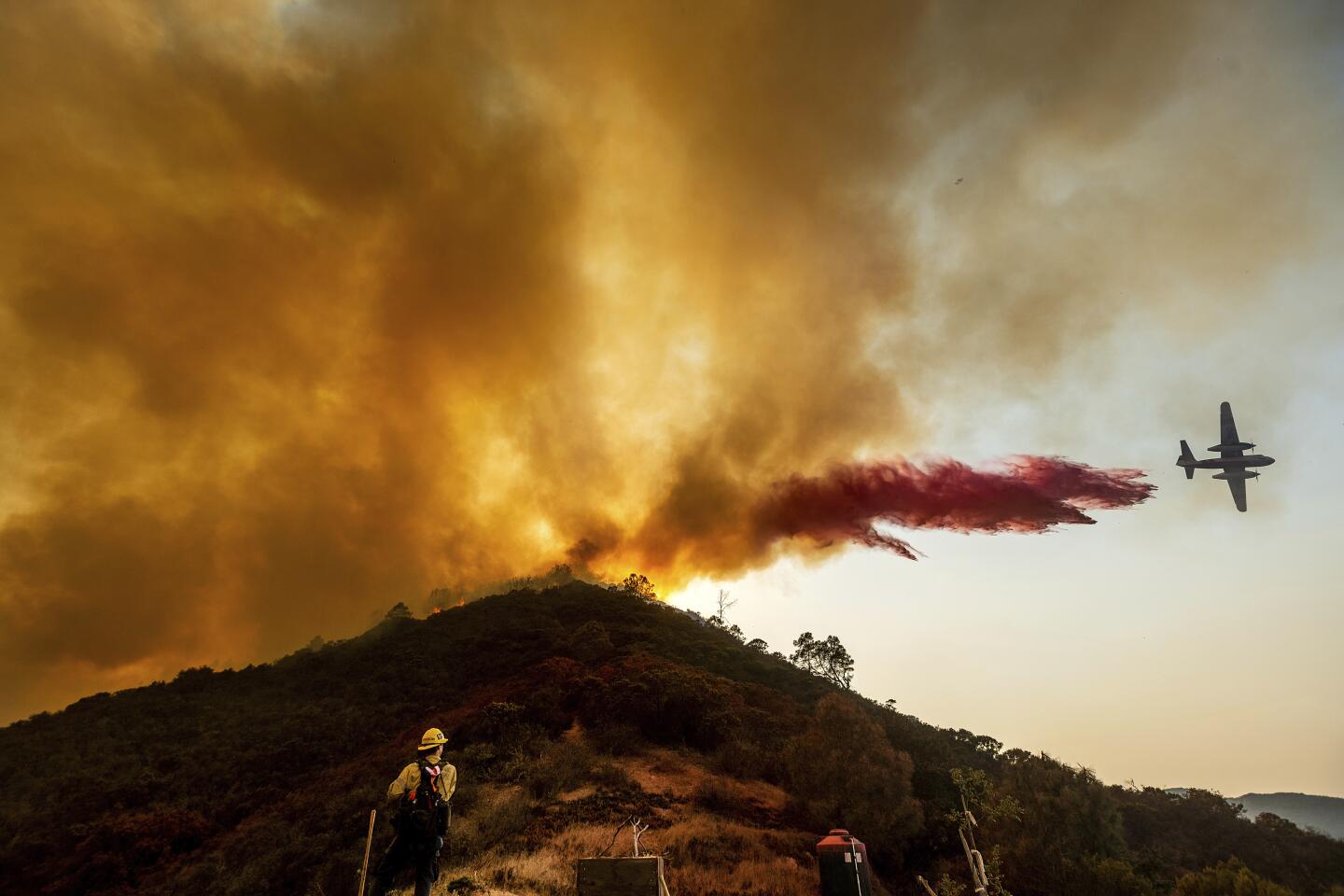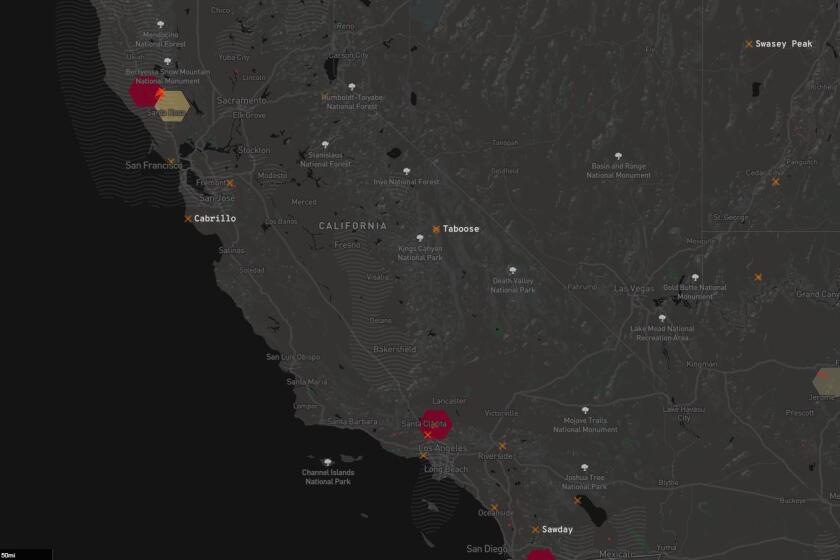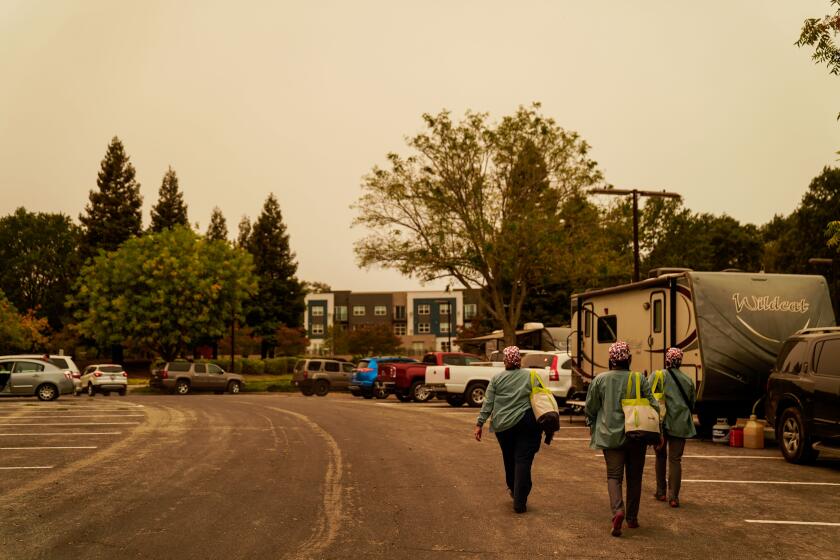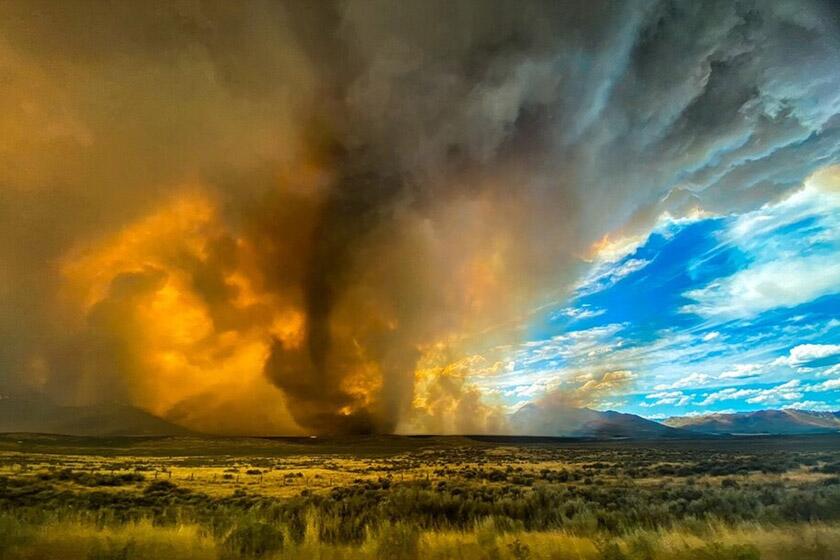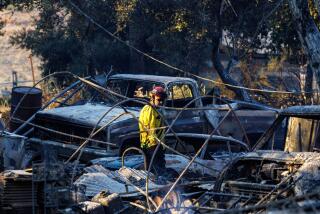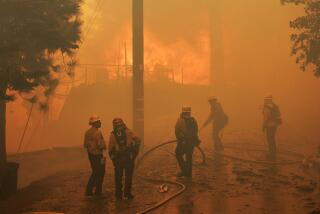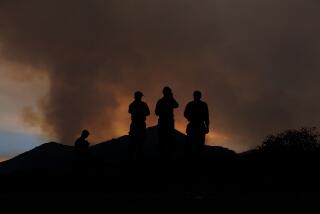At least 5 dead, nearly 700,000 acres burned as massive fires threaten Northern and Central California
SAN FRANCISCO â Wildfires ringing the Bay Area and other parts of the state killed at least five people, destroyed more than 500 structures and scorched hundreds of square miles as evacuations expanded Thursday.
In all, more than 694,000 acres have burned in Northern and Central California â the equivalent of 1,085 square miles, more than twice the size of the city of Los Angeles. The fires, fanned by strong winds, heat and low humidity, have forced more than 60,000 people to evacuate.
At least 539 structures have been destroyed, and the fire-fanning weather conditions that have brought record temperatures and thousands of lightning strikes in the past few days are not expected to abate soon.
One major cluster of fires was in the wine country. The LNU Lightning Complex fire has blackened a combined 215,000 acres, destroyed 480 structures and triggered the evacuation of nonessential personnel from Travis Air Force Base in Solano County and patients from Adventist Health St. Helena hospital in Napa County. It was 0% contained as of 7:30 p.m.
See the location of fires burning across the state in our California wildfires map.
âExtreme fire behavior with short- and long-range spotting [is] continuing to challenge firefighting efforts,â officials wrote in an update Thursday morning. âFires continue to make runs in multiple directions ... impacting multiple communities.â
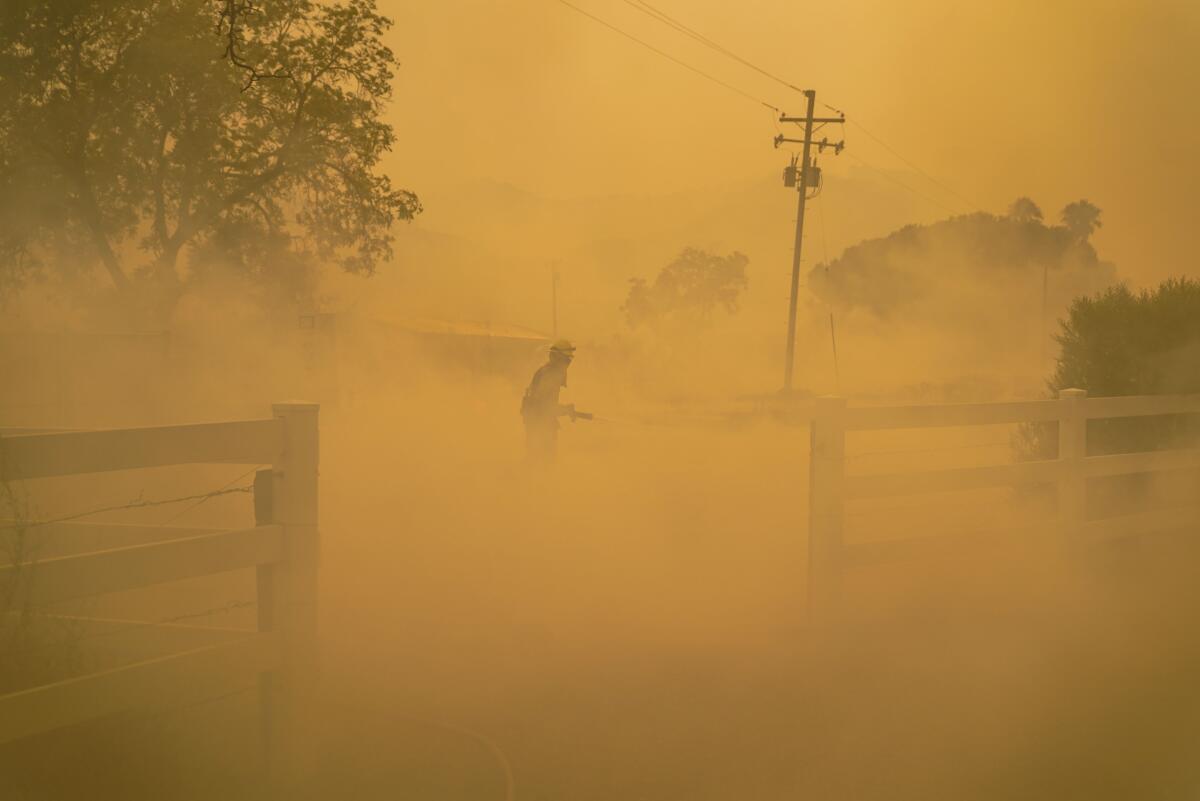
There have been reports of fatalities â including four civilian deaths tied to the LNU Lightning Complex fire and a pilot who was killed when his firefighting helicopter crashed in Fresno County on Wednesday, briefly sparking another brush fire to join the dozens burning across the state.
On Thursday, the California Department of Forestry and Fire Protection also announced the death of a Pacific Gas & Electric Co. employee who was found unresponsive in his vehicle after clearing infrastructure â such as utility poles and lines â in the Gates Canyon area outside Vacaville for crews responding to the fires. Cal Fire Assistant Deputy Director Daniel Berlant later said that the employeeâs death was determined to be unrelated to the fires so it is not included in the agencyâs fatality count.
In Sonoma County, the city of Healdsburg was under an evacuation warning early Thursday.
Sonoma County Sheriff Mark Essick stressed that residents who were ordered to evacuate should do so âcalmly yet quicklyâ and not delay in making their way to safety.
âWe also are concerned that many people are pulling over on the sides of busy highways and roads to take pictures and view the fire,â he said during a briefing. âWe really urge you to fight that urge and continue to evacuate.â
Residents also should refrain from returning to their homes until given official word to do so, he added. About 30,500 structures around the LNU Lightning Complex are still threatened.
âWe have had some minor reports of people reentering evacuation areas, and theyâve had to be rescued,â Essick said. âWhen we have to rescue you from an evacuation area, it creates a secondary burden on police and fire services and adds to the problem.â
Healdsburg resident Harvest Echols said Thursday that sheâs tired of running from fires, tired of packing up her kids, tired of her wine country town that seems to come close to burning every year.
âI want to move,â she said. âThere are lots of more relaxing places to live.â
These moments seem increasingly inevitable in Californiaâs pastoral farmlands north of San Francisco, with their rolling hills, old forests and miles of dry brown grass.
Though Healdsburg is only under an evacuation warning, Echols remembers the middle-of-the-night run she had to do last October when the Kincade fire was close enough that its orange glow crested the nearby hills. Two years before that, the Tubbs fire sent them running.
This time, it would be an organized retreat to a lake up north, an attempt to make it seem more like a vacation than another looming disaster.
Her husband, Healdsburg Vice Mayor Shaun McCaffery, said their nervousness is normal in the city, where for the last few days âpeople were getting anxiousâ and everybody is leery of the wind picking up.
âIt just kind of wears on people that they might have to go,â he said.
Others share his anxiety and the frustration that comes from frequently having to flee wildfires. Near the Healdsburg town square, Gina Gandeza smoked a cigarette in front of her chartreuse green apartment complex. A lifelong resident, she said âa lot of people have been talking about Oregon lately.â
She evacuated last year during the Kincade fire and would have done so again this week, but her two adult daughters work at businesses that are still open â a gas station and a convenience store. Those places wonât close until there is a mandatory evacuation order, she said, and she wonât leave without them.
âOf course, weâve got the car packed,â she said.
Evacuation orders were also prompted on the eastern edge of San Jose by the SCU Lightning Complex fire, which has burned more than 157,000 acres in multiple locations generally east of Silicon Valley and the East Bay and west of the Central Valley. Flames have neared the famed Lick Observatory, which serves astronomers from the University of California. It was threatening 20,000 structures and was 5% contained as of Thursday evening.
Officials on Thursday ordered additional evacuations, covering portions of San Joaquin County south of West Corral Hollow Road to the Stanislaus County line; west of the 580 Freeway to the Alameda County line; and east of the Alameda County line to the 580 and the Stanislaus County line. They also ordered new evacuations for Santa Clara County, including east of Anderson Lake and Coyote Creek, and north and east of Highway 152.
Excluded from the order are the PAR Estates and Tracy Golf and Country Club, both of which are instead under an evacuation warning.
Additional evacuation orders were issued in the path of the CZU August Lightning Complex fire, which was raging in the remote mountainous area southwest of Silicon Valley, on the border of San Mateo and Santa Cruz counties. That fire has burned 48,000 acres and forced the evacuation of at least 48,000 people, officials said Thursday evening.
Jonathan Cox, a deputy chief with Cal Fire, said the CZU fire has destroyed 50 structures and threatens 20,000 others. It is 0% contained.
The fire has caused extensive damage at Big Basin Redwoods State Park and forced the evacuation of staff, campers and other visitors. The state park, Californiaâs oldest, sustained damage to its headquarters, campgrounds and historic core. Officials with the California Department of Parks and Recreation said the agency did not yet know the number of acres that had burned within the park and were assessing the damage.
âWe are devastated to report that Big Basin, as we have known it, loved it and cherished it for generations, is gone,â said the Sempervirens Fund, an organization that focuses on protecting redwood forests and wildlife, in a statement on its website. âWe do not yet know the fate of the parkâs grandest old trees.â
Cal Fire officials said Thursday morning that the fire was extremely active overnight, creating âsignificant burning conditions that were unprecedented and unseen by veteran firefighters.â
The fire was threatening the communities of Pescadero and La Honda in San Mateo County. In Santa Cruz County, structures have been lost in the Swanton Road area, and a Cal Fire station was under threat.
The evacuation zone for this fire has expanded rapidly and now includes the communities of Davenport, Ben Lomond, Boulder Creek, Lompico, Felton and the area of Zayante Canyon. Officials also issued evacuation warnings for downtown Scotts Valley, a mountainous city of about 12,000 people just north of Santa Cruz along Highway 17. At about 7 pm, evacuation orders were issued for UC Santa Cruzâs campus, in addition to other areas.
On Twitter, the school wrote that all on-campus residents must evacuate and be prepared to not return for at least two weeks.
âI couldnât stress more the importance of leaving when those orders come out, I really canât,â Santa Cruz County Sheriffâs Chief Deputy Chris Clark said during a briefing Thursday. âThere are people that are unaccounted for that we are looking to try to determine where they are, so I stress that because, with this fire, you just donât know how things are going to go.â
Hundreds of families fled their homes in Vacaville on Wednesday. Some went to shelters, worried both about the flames and the pandemic.
The weather conditions for the next three days make the outlook grim, said Mark Brunton of Cal Fire.
âThat makes that threat very direct and very real,â he said. âWeâre doing everything we possibly can to protect life and property.â
California is struggling to battle 23 major wildfires in what has become an acute fire season in the state.
The Butte County Sheriffâs Office also issued an evacuation warning Thursday afternoon covering the areas of Philbrook Reservoir and Inskip. The county is contending with its own Lightning Complex, a collection of 34 confirmed lightning-caused fires that have burned a combined 1,900 acres.
Many of those fires are under control, fire officials said, and containment for the overall complex was reported at 20% as of Thursday morning.
According to the website PurpleAir, the Bay Area was home to the worldâs worst air quality overnight Thursday. Air quality is especially bad in Silicon Valley, San Mateo County and Livermore Valley, according to local air quality management officials.
âSmoke can irritate the eyes and airways, causing coughing, a dry scratchy throat and irritated sinuses,â the Bay Area Air Quality Management District said. âElevated particulate matter in the air can trigger wheezing in those who suffer from asthma, emphysemaâ and other chronic respiratory ailments.
âVery dry and warm conditions will persist across the interior and in the region`âs higher elevations,â the National Weather Service said. âSmoky and hazy conditions are likely to impact portions of the region through at least this upcoming weekend.â
Given the unhealthy air and continuing presence of the coronavirus â which can spread through respiratory droplets â experts suggested that staying indoors at home is safest. But, if you need to go outside, wear a mask.
âWe are in this perfect storm of a lot of uncertainty with not a ton of reassurance things are going to get substantially better in the next few months,â said Dr. Jahan Fahimi, director of UC San Franciscoâs emergency department. âI think weâre hunkering down and preparing for kind of a longer-term response to what is happening in our community.â
Toward a more sustainable California
Get Boiling Point, our newsletter exploring climate change, energy and the environment, and become part of the conversation â and the solution.
You may occasionally receive promotional content from the Los Angeles Times.
There have been more than 370 new wildfires across the state in the past four days, according to Cal Fire.
At this time last year, crews had responded to a total of 4,007 fires throughout the state, according to Gov. Gavin Newsom. Theyâve already been dispatched to at least 6,754 this year.
Formed in the last 3 million to 4 million years as tectonic plates grind past each other underneath California, the stateâs North Coast mountain range provides fires a range of slopes, canyons and cliffs to run up, funnel through and climb.
The Jarbo Gap at the Feather River channel in Butte County, for example, turned the small flames from a utility-caused grass fire outside Paradise into an inferno, said Don Hankins, a geography and planning professor at Chico State University.
As fires have revisited burn scars repeatedly in the last few years, some areas of land are transitioning from shrub and oak woodland to highly flammable invasive species, such as areas around Napa and Butte counties where ripgut brome grass is expanding, Hankins said. A similar issue plagues the Los Padres National Forest in Southern California.
At the same time, humans continue to expand and install infrastructure. The Valley fire that ravaged Lake County in 2015 was sparked by a faulty electrical connection, and the worst fires in state history, which occurred in Northern California 2017 and 2018, were caused by power lines. The area that burned from 2015-18 amounted to 50% of what had burned there in the previous 65 years, said John Abatzoglou, an associate professor in UC Mercedâs school of engineering.
âThe complex terrain [in Northern California] does make it more challenging for fire suppression and thereâs just more land for fires to take advantage of,â he said, contrasting it with Southern Californiaâs urban sprawl.
Also burning in California is the River fire, which has consumed more than 33,000 acres in steep mountainous terrain south of Salinas in Monterey County, destroying 10 structures, damaging two others and forcing mandatory evacuations, according to Cal Fire.
At least 3,000 structures remain threatened by the blaze, which was 9% contained as of Thursday evening.
The Carmel fire, burning just southwest of the River fire, has charred more than 4,400 acres and destroyed 28 structures, fire officials said.
Crews are also battling a sizable blaze in Tehama County. The Elkhorn fire, originally referred to as the 3-4 fire, broke out southwest of Red Bank Road on Wednesday and has already grown to 15,250 acres and prompted a number of evacuations.
Thereâs promising news, however, out of Southern California, where firefighters are making progress on a few older wildfires.
The Lake fire, which has burned more than 27,000 acres in Los Angeles County near Lake Hughes, is now 52% contained, officials said Thursday evening. That blaze, which started Aug. 12, has destroyed 12 structures and 21 outbuildings.
Officials also reported 39% containment on the Ranch 2 fire near Azusa. That more than 4,000-acre fire started Aug. 13 and is the result of suspected arson, authorities say.
Crews are also nearing full containment of the Apple fire, which has charred 33,424 acres in the Inland Empire since it broke out July 31.
Videos posted to social media showed twister-like formations in the path of the Loyalton fire, which started Friday evening in the Tahoe National Forest.
Progress anywhere is welcome news in fire-ravaged California, where the rapid outbreak of new blazes has stretched the stateâs firefighting resources to their limit.
Getting a handle on some fires, officials said, will free additional assets that can then be redeployed as needed.
Given the severity of the stateâs firestorm, California also has turned to some of its fellow states for assistance.
Jeremy Rahn, the lead Cal Fire public information officer for the LNU Lightning Complex fire, said Wednesday that the state had already requested 375 additional fire engines as well as additional hand crews from out-of-state agencies, and hired ânearly all available private firefighting âcall when neededâ aircraft in the Western United States.â
At a media briefing Thursday morning for the LNU Lightning Complex incident, Cal Fire firefighters warned that it would take time to get control of the fires, with officials saying they were short on manpower and resources.
âThis is a very large fire. Itâs one of many in the state of California, and honestly, our resources are stretched,â said Shana Jones, a Cal Fire chief with the agencyâs Sonoma and Lake counties unit.
Cal Fire Incident Commander Sean Kavanaugh said the sheer number of fires statewide has meant that the fire zone in Sonoma, Lake, Napa, Solano and Yolo counties has not received the firefighting manpower officials had been accustomed to getting.
âWeâre used to lots of resources, and thatâs not where weâre at today,â he said. âWith the amount of large fires that we have throughout the entire Northern California, weâre just one small piece of the bigger picture.â
Kavanaugh said in the coming days, there will be additional resources coming in from out of state, and heâs hoping personnel who are fighting smaller fires in other counties â where theyâve made progress surrounding fires with containment lines â will be brought to the LNU Lightning Complex fires in the North Bay, which is 0% contained.
Newsom announced Thursday that the state had received a grant from the Federal Emergency Management Agency that will allow local, state and tribal governments responding to the CZU August Lightning Complex fire to receive reimbursement for up to 75% of certain firefighting costs.
The state has also secured grants over the last week to help fight blazes in Monterey, Napa and Nevada counties.
Another wrinkle in this yearâs fire season is the ongoing COVID-19 pandemic, which has raised concerns among displaced residents who would normally pack into emergency shelters and created new challenges for the agencies that operate them.
âThis is obviously a new dynamic that weâre dealing with across the state in the COVID moment,â Cox, the Cal Fire deputy chief, said. âThe recommendation ... is try to find family and friends that you are comfortable with before you go into these large environments with multiple people where they may be an additional risk for exposure.â
Lin reported from San Francisco and Miller, Money and Serna from Los Angeles. Times staff writers Anita Chabria in Vacaville, Taryn Luna in Sacramento, Susanne Rust in San Francisco and Colleen Shalby in Los Angeles contributed to this report.
More to Read
Sign up for Essential California
The most important California stories and recommendations in your inbox every morning.
You may occasionally receive promotional content from the Los Angeles Times.
